Travel to Bhutan and you’ll enjoy one of the most special and unusual destinations this planet has to offer. Bhutan is a destination I had been hoping to visit for some time, and it finally happened this year.
I was deciding between three destinations for my big solo trip this fall — either Bhutan, Uzbekistan, or Morocco. One of my readers suggested prioritizing the most physically demanding trip first, and I knew going to the high-altitude trekking destination of Bhutan was the right decision.
And I was blown away by Bhutan.
Bhutan, the Land of the Thunder Dragon, is an isolated enclave in the Himalayas. I have never been anywhere else like it. This is a country that prioritizes happiness first; a country overflowing with natural beauty; a country where it feels like you’ve gone back in time.
Let’s take a look at Bhutan — what my solo trip to Bhutan was like, and what you need to know before planning a trip there yourself.
This post was published in November 2024.
Table of Contents
Toggle- Bhutan is an isolated country in the Himalayas.
- Bhutan values sustainability and limits tourism.
- You need to visit Bhutan with a guide or tour.
- Where do you go in Bhutan?
- Bhutanese people wear traditional clothing most of the time.
- Bhutan is a kingdom.
- The temples are incredible, but you can’t photograph them.
- Tiger’s Nest is the ultimate Bhutan experience!
- Bhutan has a lot of quirks.
- Farmhouse homestays are a way to experience rural life in Bhutan.
- How much does a trip to Bhutan cost?
- What’s Bhutanese food like?
- How do you get to Bhutan?
- Flying into and out of Bhutan is spectacular.
- When is the best time to visit Bhutan?
- Internet is not great in Bhutan.
- Communication can be a bit tough sometimes.
- Bhutan is not without its issues.
- Visiting Nepal after Bhutan is jarring.
- Bhutan Packing List
- Is Bhutan Worth It?
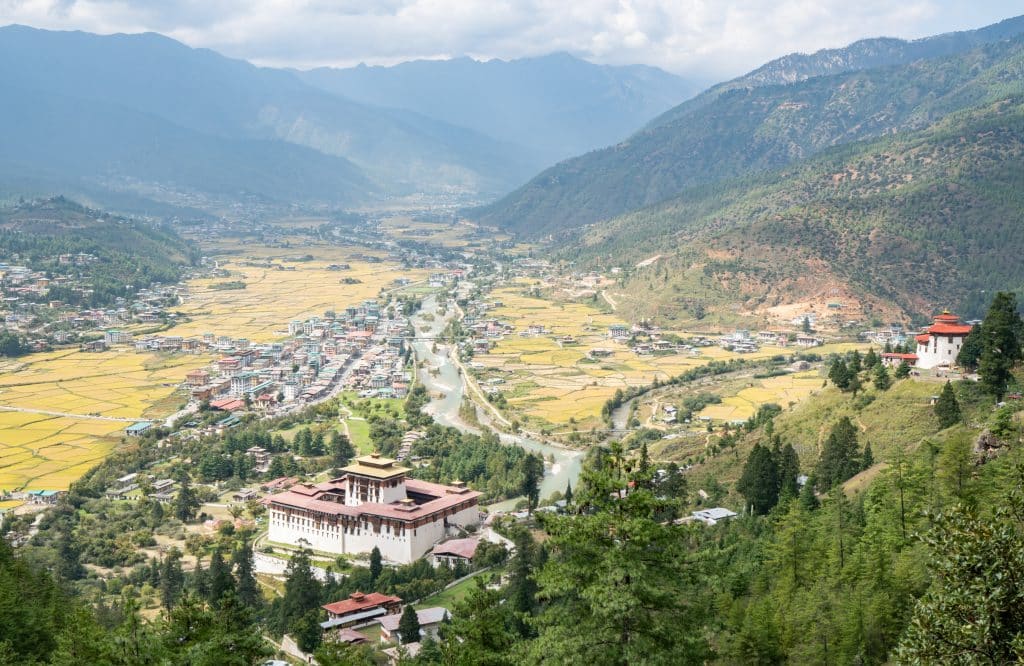 The riverside city of Paro, Bhutan, with Paro Dzong in the foreground.
The riverside city of Paro, Bhutan, with Paro Dzong in the foreground.Bhutan is an isolated country in the Himalayas.
It strikes me how many people haven’t heard of Bhutan before. Bhutan is located in the Himalayas, nestled between India and China. Kathmandu, Nepal, is the nearest major city, one hour away by flight.
You can also enter by road from Northeast India, which is doable, but very few tourists do this. There are no land crossings into China (which is technically the Tibet region).
So why do people travel to Bhutan?
Mountains. The Himalayas here are spectacular, and there are so many outstanding trekking opportunities. Most travelers finish their trip with a hike to Tiger’s Nest Monastery, one of the symbols of the country. If you’re a hardcore hiker, there are plenty more beautiful and challenging opportunities.
Cultural tourism. Bhutan is home to the most beautiful temples I’ve ever seen, and the people wear gorgeous traditional clothing. That, plus the traditional architecture, the festivals, the dances — there’s so much! Bhutan is also a popular destination for travelers interested in Buddhism.
A huge draw for the well-traveled. If you’ve visited a lot of places, it gets harder to be impressed. As my 87th country, Bhutan impressed the hell out of me.
Absolute peace. Bhutan is an incredibly safe destination to visit, and one of the most peaceful places I have ever visited in my travels. It’s like Japan, but less frenetic. Like Iceland, but less touristy. Like Switzerland, but far more affordable.
Being so isolated has worked to Bhutan’s advantage — the country only opened to tourism in 1974 and has limited tourism in the years since.
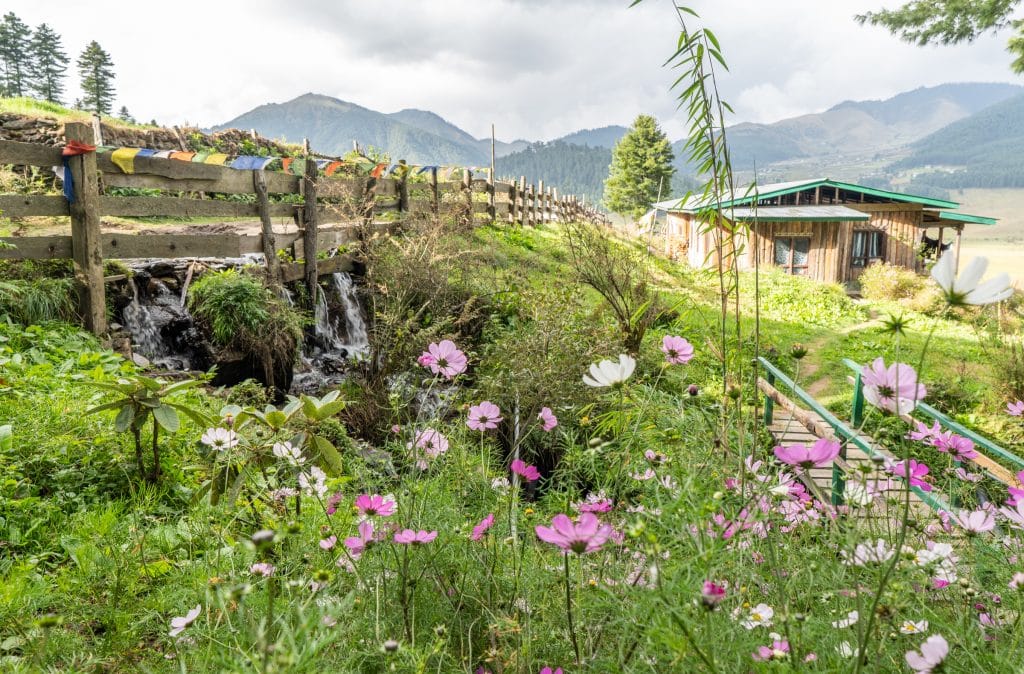 I loved this shot near the Gangtey Black-Necked Crane Center.
I loved this shot near the Gangtey Black-Necked Crane Center.Bhutan values sustainability and limits tourism.
If you know anything about Bhutan, it may be their focus on sustainability — or their emphasis on Gross National Happiness. It’s just as important, if not more, than Gross Domestic Product.
Since the 1970s, the government of Bhutan has focused on four pillars of GNH: sustainable development, environmental conservation, preservation of traditional culture, and good governance.
In other words, Bhutan walks the walk when it comes to sustainability.
It’s a law in Bhutan that 60% of the nation must be covered in forest; at the moment, 70% of the country is covered in dense forests. Bhutan gets most of its power from hydroelectric power, rather than fossil fuels, and the country hopes to reach net zero greenhouse gases by 2030. Bhutan is carbon negative as a result.
Because of this, Bhutan wants to limit their tourism to high value tourists who can visit without making a negative impact on the environment. To do this, Bhutan charges all travelers a $100 daily fee called the Sustainable Development Fee, or SDF. You pay it through your tour company.
The SDF is currently lower than usual — it was reduced from $200 a few years ago, and is currently scheduled to return to $200 in 2027.
If the Bhutanese didn’t charge this fee, Paro would look like Pokhara, Nepal — full of backpacker bars with shot specials, bare-bones hostels, massage places every two steps. They don’t want that for themselves. They would rather welcome fewer tourists spending more money.
One other thing — travel insurance is required for visits to Bhutan. It’s a good idea to have travel insurance for every trip, but especially here, because you might need a medical evacuation to a country with better facilities.
While I use a Czech policy these days, I used to use World Nomads for travel insurance when I lived in the US, and I recommend it for North American travelers.
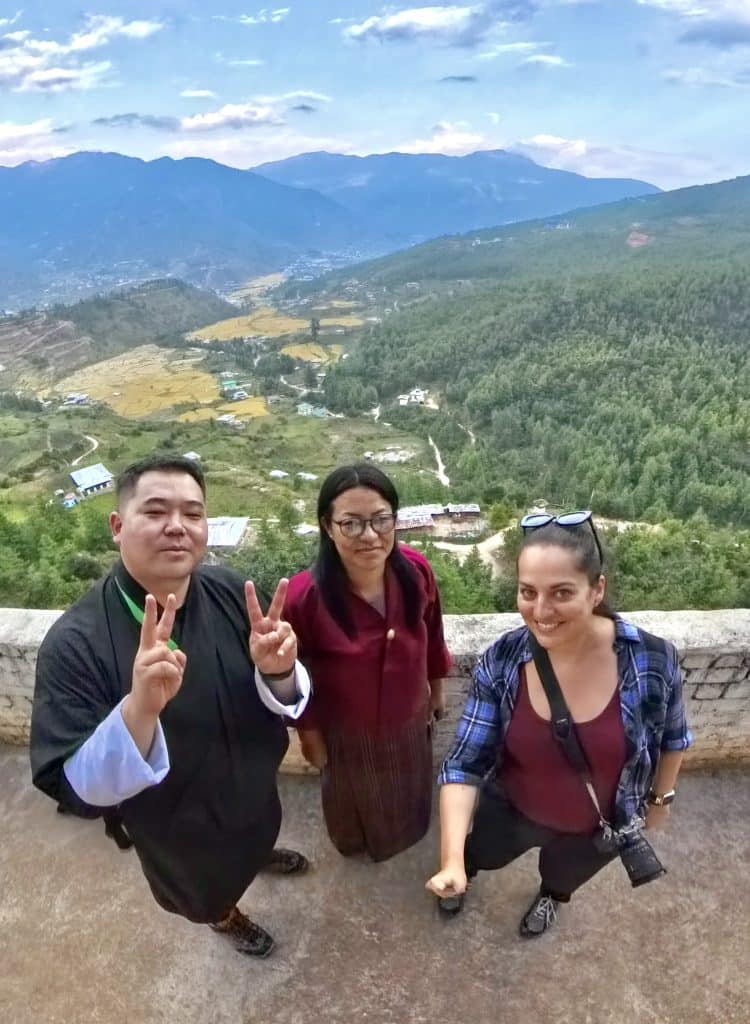 My guide Sonam, my driver Kencho, and me at the “baby Tiger’s Nest” in Paro.
My guide Sonam, my driver Kencho, and me at the “baby Tiger’s Nest” in Paro.You need to visit Bhutan with a guide or tour.
If you’re looking to travel to Bhutan, you need to work with a tour guide or a tour organization. This is the only way you can get a visa and the only way you can travel the country.
Bhutan doesn’t allow much independent travel at all — technically, an independent traveler can travel between the cities of Paro and Thimphu, but can’t travel beyond that area, and even in those cities they can’t visit any attractions without a guide. If you’re here on a tourist visa, you can’t visit attractions without a guide signing you in.
So you need to decide whether you’d rather take a Bhutan tour with a big group, or travel independently with your own private guide and driver.
Earlier this year, Bhutan Travel Center reached out to me, asking to work together. Ultimately, we planned a weeklong trip in October; they covered the cost of the trip itself, while I paid the SDF ($700 for seven days). More on the total cost below.
I had my own guide and driver for the full week! My guide was Sonam, a Bhutanese guy in his thirties with an incredible knowledge of his country and a great personality. In a crazy coincidence, Sonam and I lived in New York at the same time! He came to America to study tourism.
My driver was Kencho, and it’s so rare to have a woman as a driver! She was fabulous on the twisty roads deep in the mountains.
If you are interested in booking Sonam as your guide, contact Bhutan Travel Center and request Sonam Namgay for your guide. Keep in mind that he’s just one guy, and he gets busy!
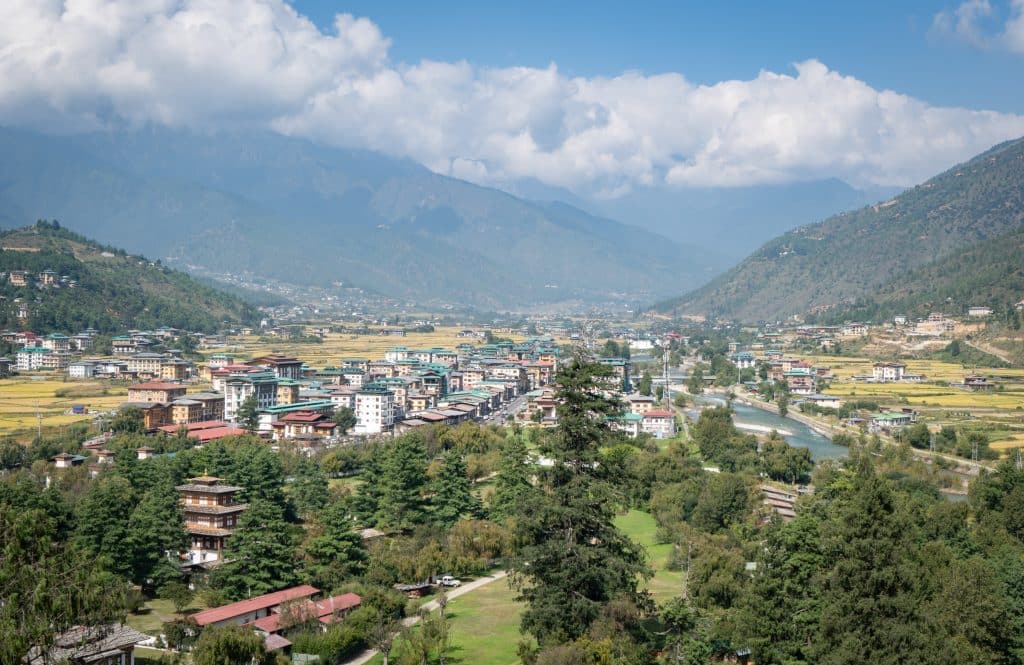 Paro, Bhutan, is where you start and end your trip.
Paro, Bhutan, is where you start and end your trip.Where do you go in Bhutan?
Your tour company can craft you an itinerary that is perfect for you, and it could take you anywhere within the country. But if you’re visiting for a week, like most travelers to Bhutan, you’ll probably stick to the four main hotspots in the western part of the country.
Paro
Paro is a small riverside city home to the airport and Tiger’s Nest, so you’ll probably stay here at the beginning and end of your trip.
Paro has a nice, walkable downtown with tons of souvenir shops — this is where you should do your shopping. And beyond Tiger’s Nest, there are a lot of treks in the area. Also, make some time to watch the planes landing at the airport — it’s fun!
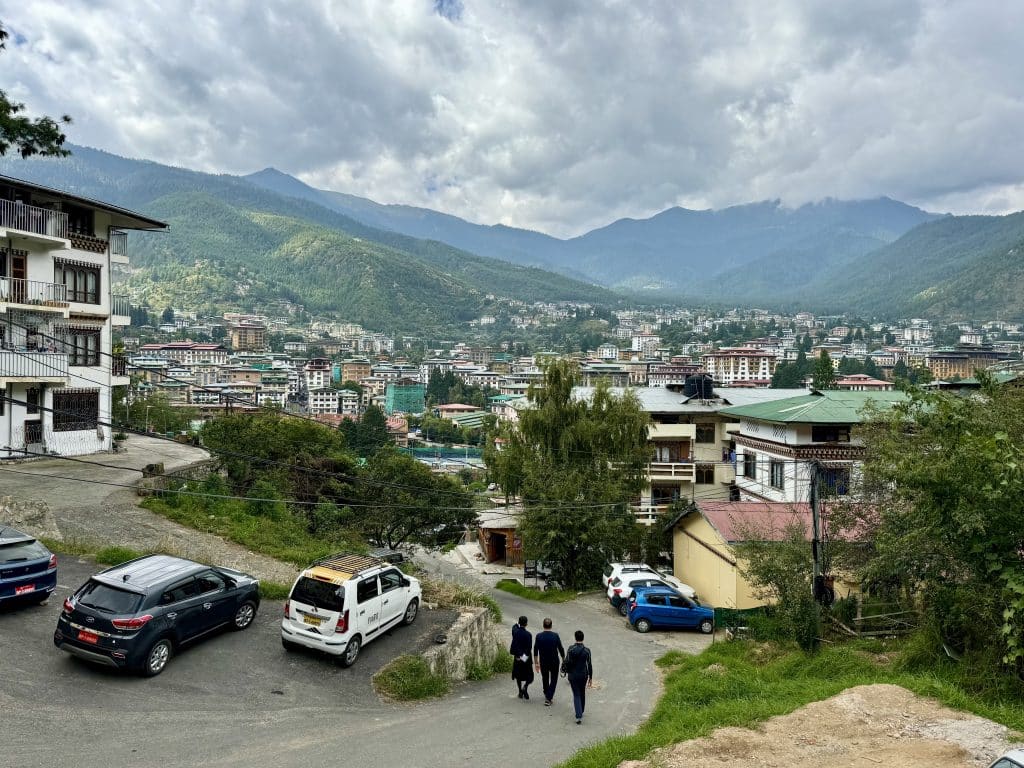
Thimphu
Thimphu is the capital city of Bhutan, the largest city in the country, and has a population of 114,000.
Here in Thimphu you’ll find some notable temples; the Royal Takin Preserve, home to the national animal that looks like a cross between a cow and a goat; an art school you can visit, and the most varied international dining and nightlife you can find in the country.
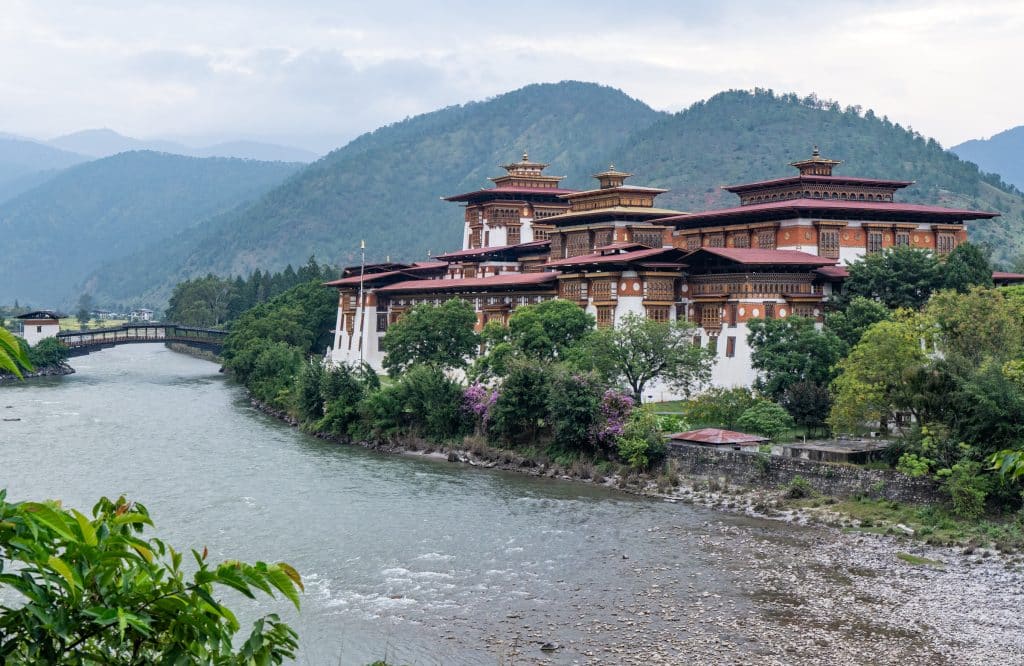 Punakha Dzong is the symbol of Punakha — and the country.
Punakha Dzong is the symbol of Punakha — and the country.Punakha
Punakha is in a more rural area, and is home to what many Bhutanese people consider the most beautiful building in the country: Punakha Dzong.
Punakha Dzong is where the King and Queen were married, and it attracts a LOT of visitors. The longest suspension bridge in Bhutan is here as well. This is one of the rural areas where you can spend additional time soaking up the atmosphere.
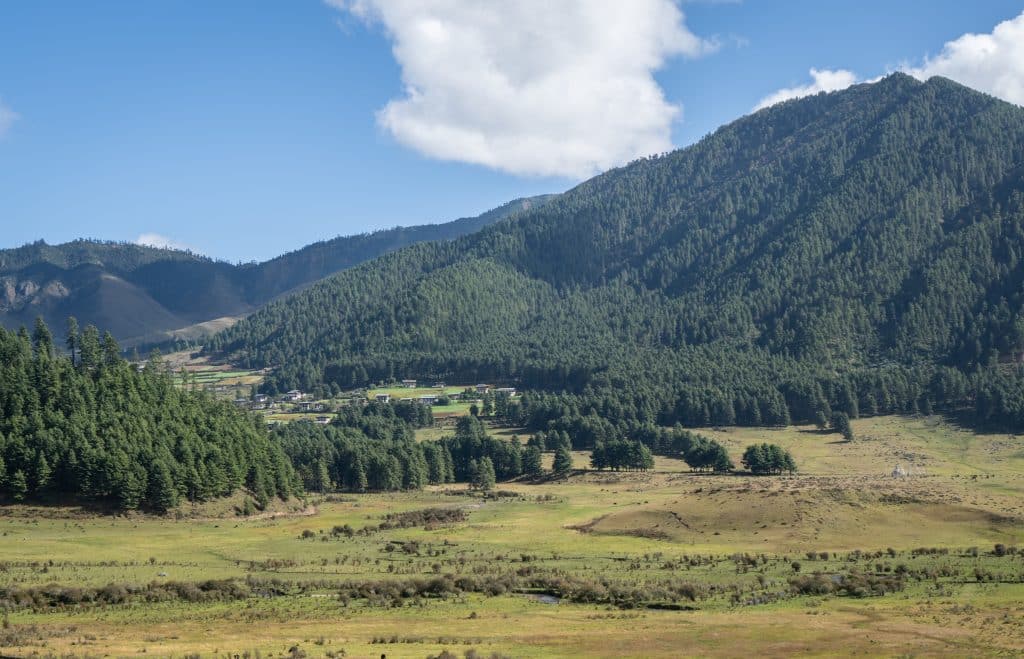 Gangtey was SO beautiful when the sun came out!
Gangtey was SO beautiful when the sun came out!Gangtey
Gangtey is a rural valley home to farmhouses, and the black-necked crane, one of Bhutan’s most beloved creatures, migrates here each year.
The Black-Necked Crane Visitor Center is worth a visit, as is Gangtey Monastery. Lots of farmhouse stays are in this part of the country.
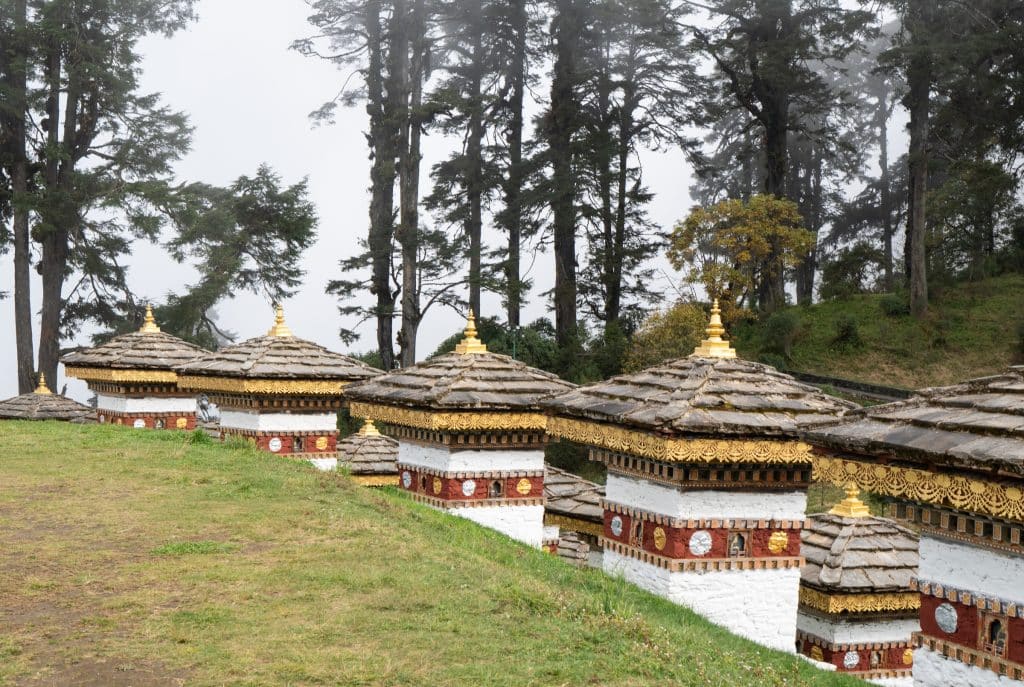 Dochula Pass is worth a quick visit.
Dochula Pass is worth a quick visit.Other Places in Bhutan
Beyond these spots, you’ll probably stop at a few adjacent places. Dochula is a high mountain pass that you drive through, and it has beautiful monuments set amongst the clouds. Lobesa is just outside Punakha and home to Chimi Lakhang, a famous fertility temple.
Want to go further afield, to central Bhutan or even remote eastern Bhutan? You absolutely can — just tell your company as you plan your trip.
I met a solo traveler interested in trekking and Buddhism (talk about Bhutan being the perfect country for him!) and he had an intense two-week itinerary crafted just for him. He actually hiked DOWN into Tiger’s Nest.
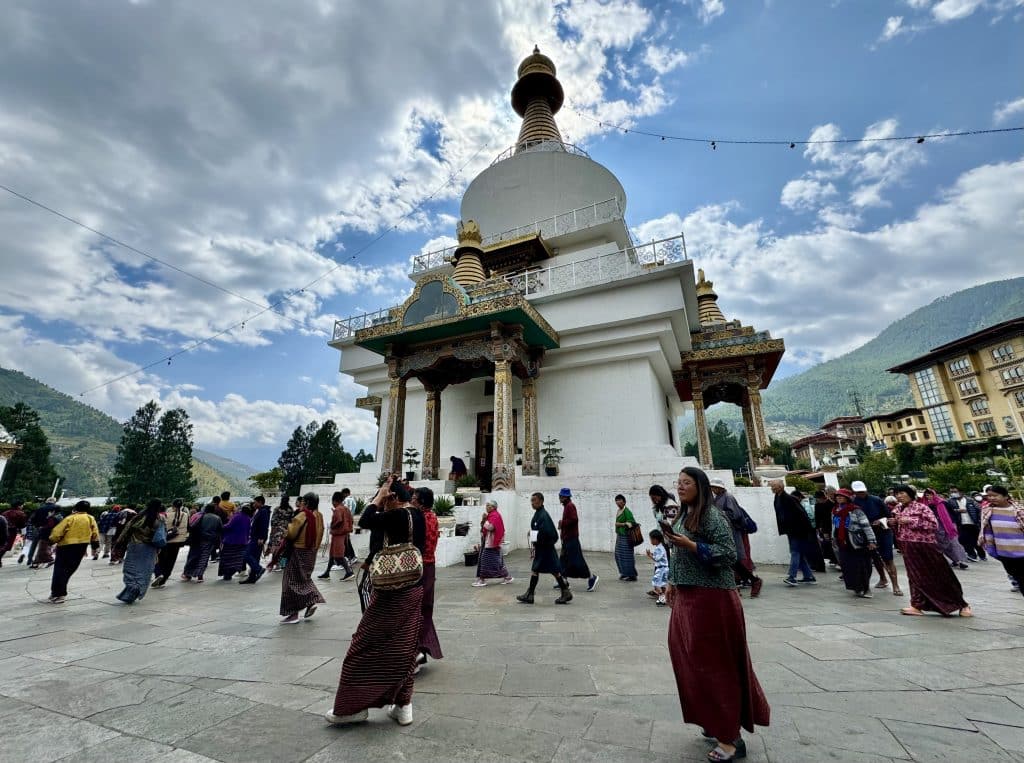 I loved the clothing on display at National Memorial Chorten in Thimphu.
I loved the clothing on display at National Memorial Chorten in Thimphu.Bhutanese people wear traditional clothing most of the time.
One of the things I loved most about visiting Bhutan was seeing so many people wearing traditional outfits!
Bhutanese people are required to wear “formal dress,” meaning their traditional outfits, when visiting government buildings or sacred sites, as well as at many jobs.
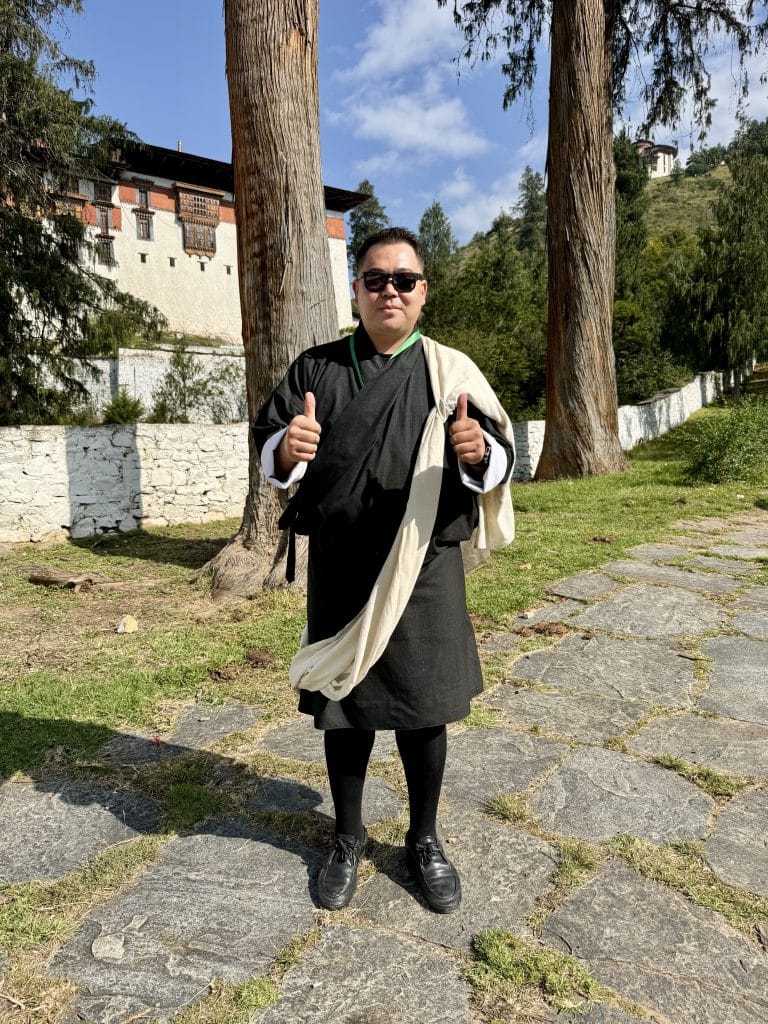 Sonam looking cool in his gho and kabney!
Sonam looking cool in his gho and kabney!The men wear a gho, a knee-length robe with long sleeves, often paired with tall black socks and black leather shoes. It’s paired with a kabney, a scarf draped over one shoulder.
Ordinary men wear white; Bhutanese government officials wear orange; judicial officials wear red; the king wears yellow.
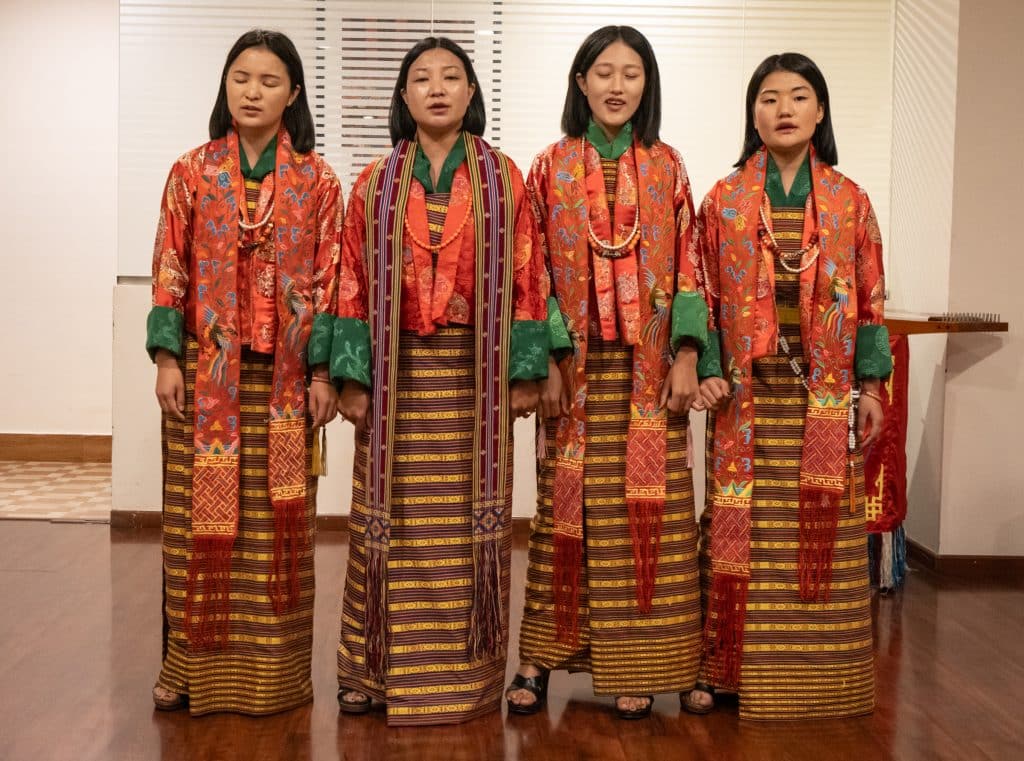
The women wear a kira, a beautifully patterned ankle-length skirt wrapped tightly around the body. It is topped with a wonju, a base layer blouse, and a toego, a traditional jacket in a satiny fabric with big, contrasting cuffs.
It’s paired with a rachu, an embroidered scarf similar in purpose to the men’s kabney, but much prettier and more colorful!
The women’s outfits are especially beautiful, and it adds to your photos to see so many people dressed up! This is just another way that the Bhutanese are preserving their cultural heritage.
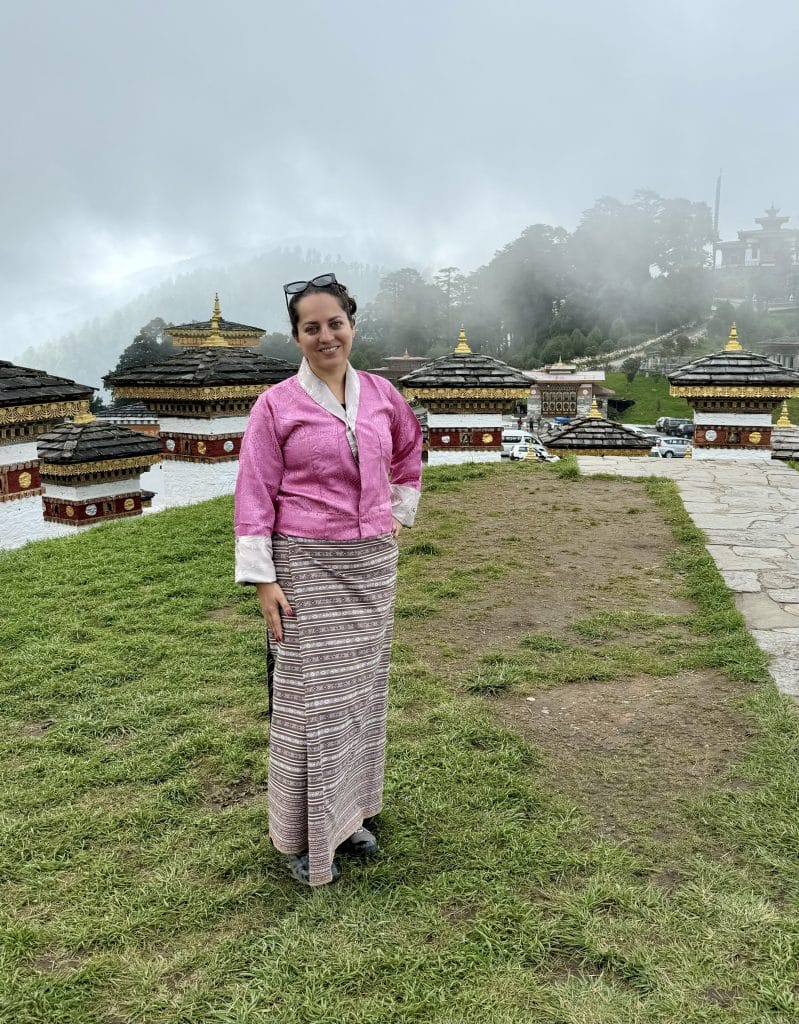
Bhutan Travel Center actually got me my own kira and toego and encouraged me to wear it when out one day. It was so nice, and I loved the colors! It definitely added something to my own photos.
I spent time with a group of expats one night in Thimphu, thanks to my reader Cate, who works at a nonprofit organization in Thimphu and generously invited me out.
They shared that when you live in Bhutan, you notice that a lot of people change into western clothes as soon as the workday is over. Formal dress is required for many jobs in Bhutan, but a lot of people don’t keep it up all day.
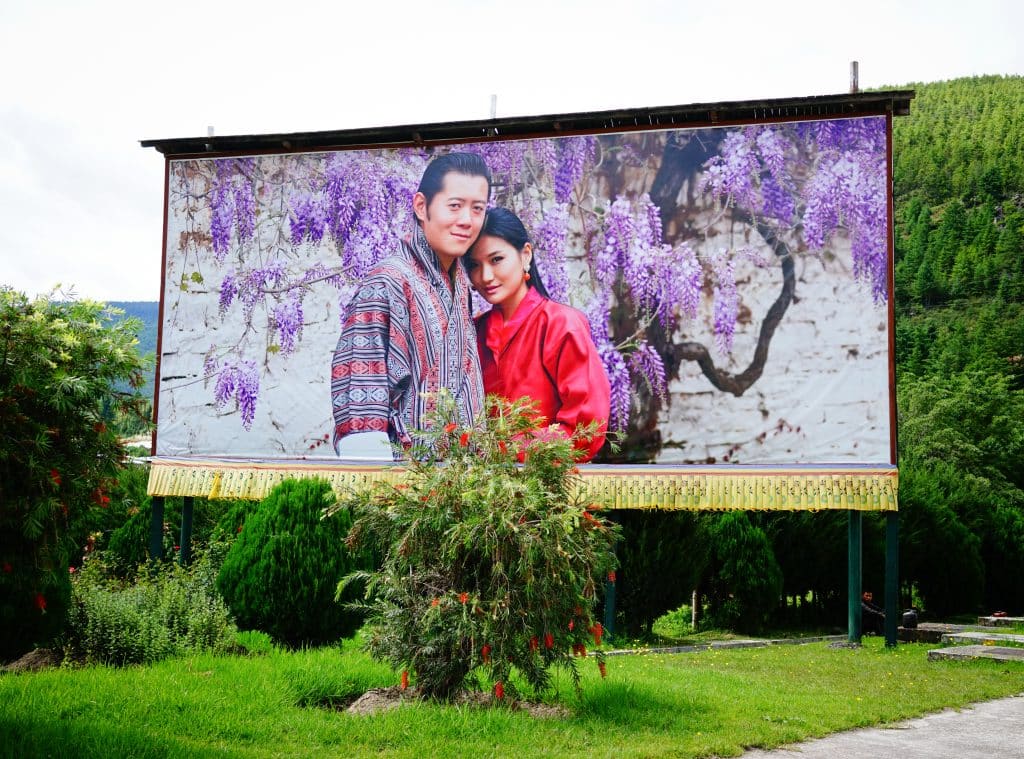 Bhutan’s king and queen, via Phuong D. Nguyen on Shutterstock.
Bhutan’s king and queen, via Phuong D. Nguyen on Shutterstock.Bhutan is a kingdom.
I enjoyed learning about the Bhutanese royal family. The Bhutanese people love their king. He’s quite a young king — he’s 44 years old now, and his father abdicated the throne in 2006.
And he is very much beloved for the most part (though of course, I can’t speak for every Bhutanese person in the world). He seems like the former Thai king that way.
And as a Massachusetts native, I was delighted to learn that the king spent so many years in Massachusetts!
He went to Phillips Academy in Andover for high school (just 10 minutes down the road from where I grew up!), followed by Cushing Academy in Ashburnham, near Fitchburg. Then he went to Wheaton College in Norton, before moving on to Oxford in the UK.
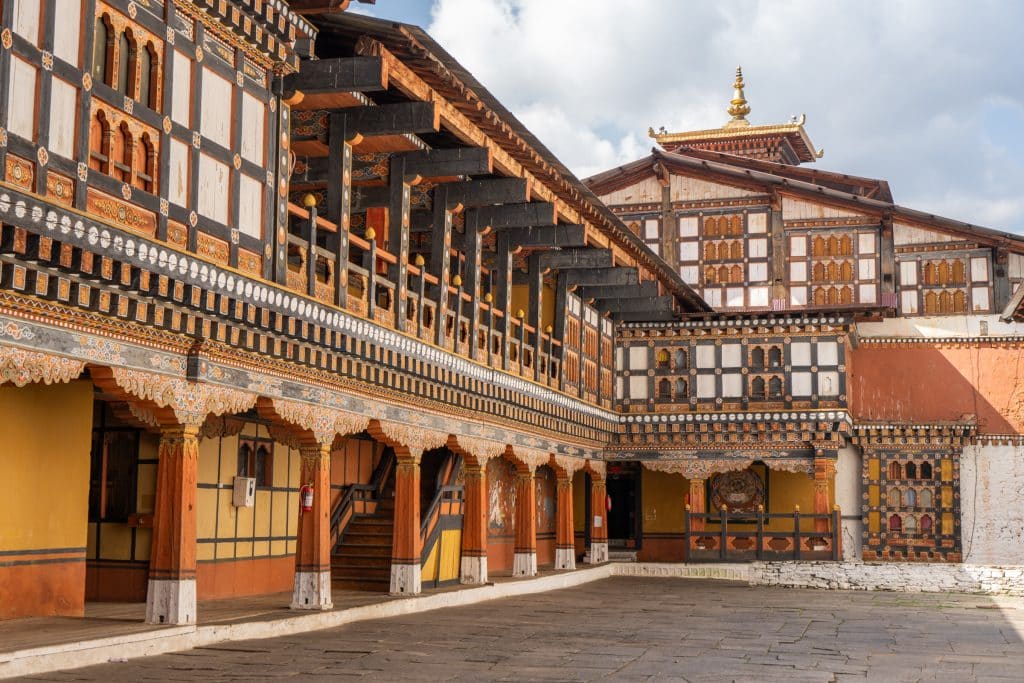 The interior of Paro Dzong, which you can photograph, but you can’t photograph the colorful temples inside.
The interior of Paro Dzong, which you can photograph, but you can’t photograph the colorful temples inside.The temples are incredible, but you can’t photograph them.
As a photographer, I fully accept that some places are not to be photographed — but I had no idea that every single temple in Bhutan would be off-limits to photography! You can’t take photos in any of them, and to even think of sneaking one would be highly disrespectful.
But the temples of Bhutan are some of the most beautiful and intricate temples I’ve ever seen, anywhere! The murals, the brightly colored lanterns with pieces of fabric in a rainbow gradient, the gold statues and patterns everywhere. It’s an absolute feast for the eyes.
Because of this, I tried to take mental pictures, remembering specific details about the temples I visited.
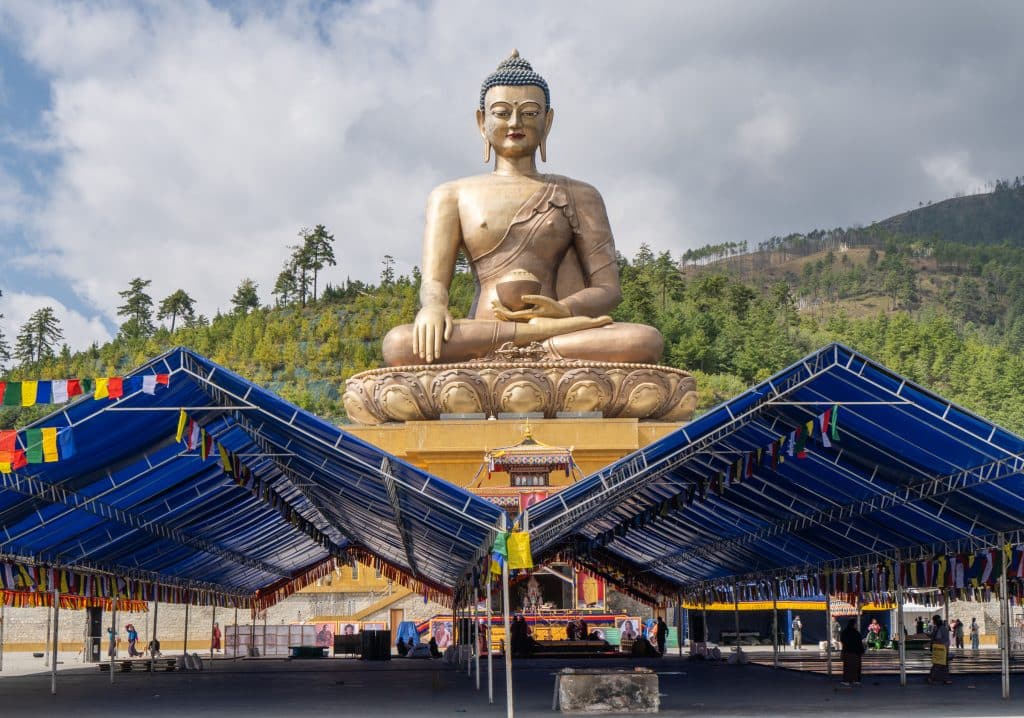 Buddha Dordenmu Statue overlooking Thimphu, Bhutan
Buddha Dordenmu Statue overlooking Thimphu, BhutanBhutan is a devout Buddhist country. I’ve traveled in several Buddhist countries, so I knew basic etiquette, but if you haven’t, here’s what you should know: take your shoes off before going into a temple. Dress conservatively (cover your shoulders and knees); considering most Bhutan visitors wear hiking gear all day, you probably won’t have a problem with that.
Don’t point your feet at the Buddha, don’t point your feet at any person, don’t touch anyone’s head, and don’t sit on the ground with your legs pointing outward (if you’re a westerner, this gets tougher as you age).
There are some differences from other largely Buddhist countries. Thailand, for example, doesn’t put any restrictions on temple photography, but people are told not to take photos with their back to the Buddha. In Bhutan, Sonam offered to take a photo of me in front of the giant golden Buddha in Thimphu and I politely declined, but he said it’s okay there! (I still declined.)
Here’s a big tip: If you choose to pray in a temple, DO NOT SAY WHAT YOU PRAYED FOR. I made the mistake of mentioning I prayed for a friend, and Sonam recoiled and told me, “No, no, you must keep it a secret!”
One thing that annoyed me a bit was wearing my lace-up hiking shoes to temples, as I was constantly taking them on and off. I usually wear sandals in Southeast Asia and slip-on shoes in Japan, which makes things a lot easier.
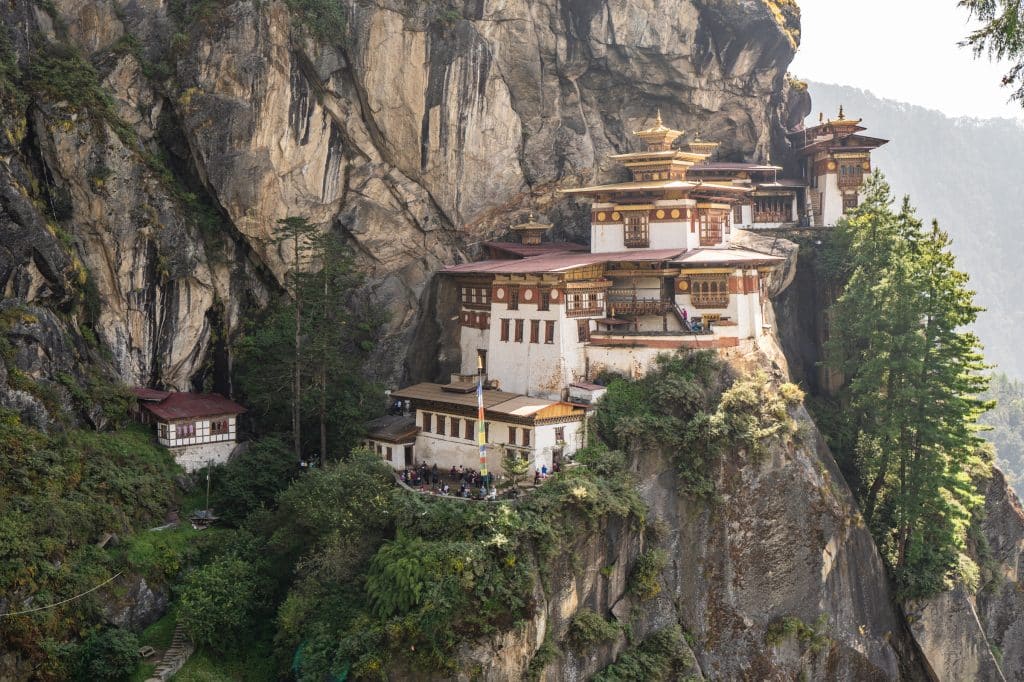 Getting to this view is SO worth it.
Getting to this view is SO worth it.Tiger’s Nest is the ultimate Bhutan experience!
If you’ve seen one photo of Bhutan, it’s probably Tiger’s Nest — a monastery built on the edge of a rocky cliff, nestled into the mountains. Hiking to Tiger’s Nest (also known as Paro Taktsang) is THE thing to do here — and it’s usually saved for the final day of your trip.
Why? Because of the altitude! The altitude of hiking Tiger’s Nest ranges from 2590-3085 meters (8497-10121 feet). The higher you go, the thinner the oxygen is — so if you’re not properly acclimatized, you’ll get exhausted so easily.
I’m someone who struggles a lot with altitude, taking a long time to adjust. This is one reason why I wanted to prioritize a trip to Bhutan before I got much older.
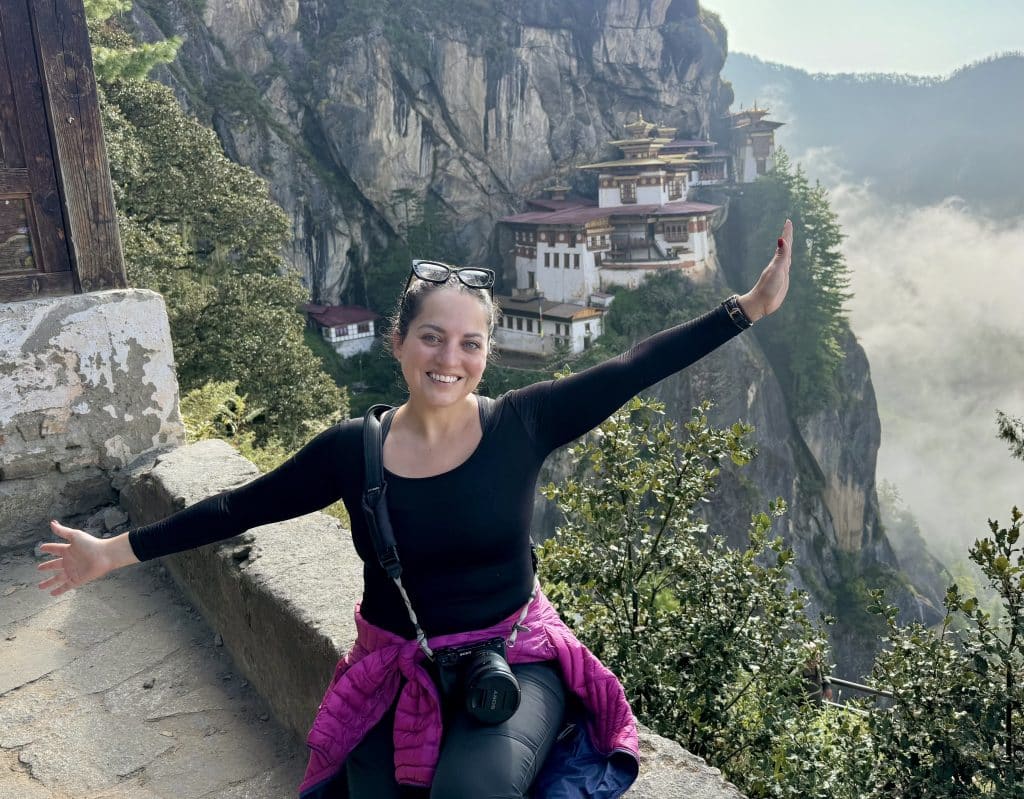
It also helped that I spent the first two days of my trip at The Terraces Resort & Spa, up in the mountains overlooking Kathmandu. That altitude was about 1990 meters (6528 feet). I did some short, gentle hikes while there, panting the whole time, and I think it helped me acclimatize in time for Tiger’s Nest.
So how is the Tiger’s Nest hike, by the way? I’d classify it as a moderate hike, with nothing too technical you need to worry about. The altitude is the main challenge.
My goal was to make it to the viewpoint within two hours, and I made it in 1:36. From there it was a 34-minute down-and-up climb to Tiger’s Nest itself. I’m a moderately fit person; it might take you longer or shorter.
I feel like I might write a full post on hiking Tiger’s Nest. Of course, your guide will give you good advice, but my big advice is to start EARLY, to rent a WALKING STICK for 100 BTN ($1), and to NOT stop in the café halfway up (it will slow your momentum — save it for celebrating on the way down).
But this hike was ABSOLUTELY worth it, so many times over, and I’m so glad I did it.
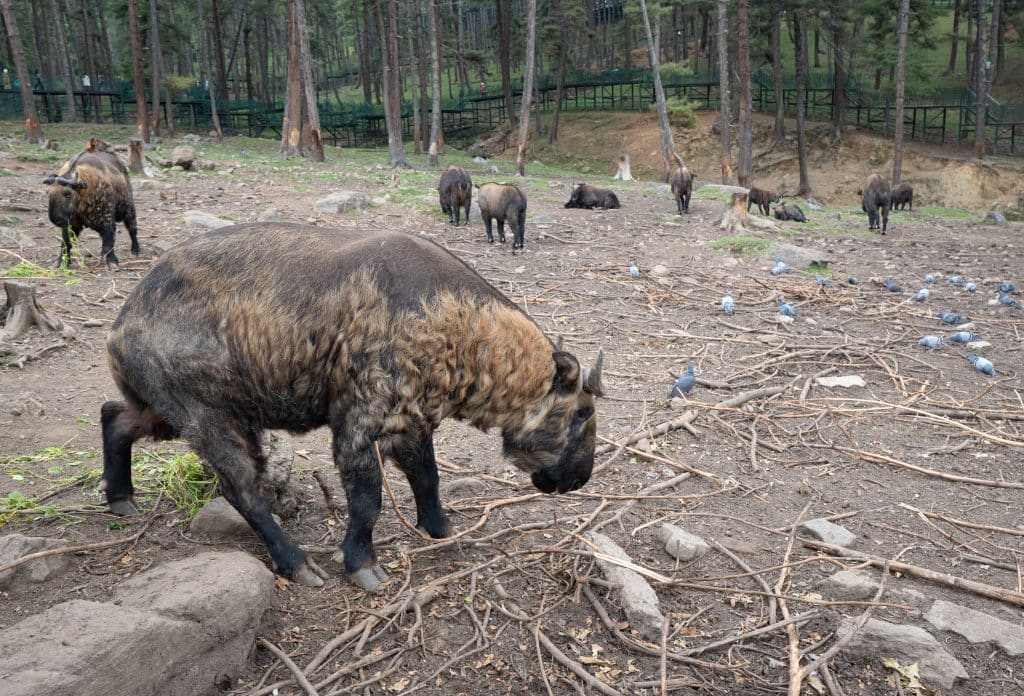 Say hello to the takins in Thimphu!
Say hello to the takins in Thimphu!Bhutan has a lot of quirks.
Here are some additional fun facts about Bhutan that you might find interesting:
Archery is the national sport of Bhutan. All of the Bhutan’s Olympians have been archers, except for one air rifle shooter in the 2012 Winter Games.
One night by my hotel in Paro, I saw a bunch of men hanging out, drinking beers, and taking turns shooting arrows. I’ve never seen that anywhere — so cool!
The takin is the national animal of Bhutan. You can visit the Royal Takin Preserve in Thimphu to see these furry creatures. Legend has it that the Divine Madman, a notable Buddhist monk, created the takin from a goat’s head and a cow’s body!
You sometimes see big wasps’ nests perched on the edge of dzongs (fortresses). They actually bring good luck, so people leave them be!
There are no traffic lights anywhere in Bhutan. There used to be one in Thimphu, but locals HATED it — so they replaced it with a “human traffic light” with men directing traffic from a small booth in the intersection.
Every building in Bhutan is built in the same traditional style, without nails required. You won’t see a plain modern building in this country!
You’ll see a lot of colorful phalluses. The phallus is a fertility symbol, and it also brings good luck, generally. You’ll see it painted on walls in different towns, and you’ll see plenty of colorful phalluses for sale in Paro.
If you visit the temple of Chimi Lakhang in Lobesa, outside Punakha, you can do a fertility ritual that involves carrying a giant phallus on your back around the temple.
Bhutan was the last country in the world to get both internet and television! They got both in the year 1999.
Before that, Sonam told me, people would get in a LOT of trouble for sneaking in TVs and hooking them up to satellite.
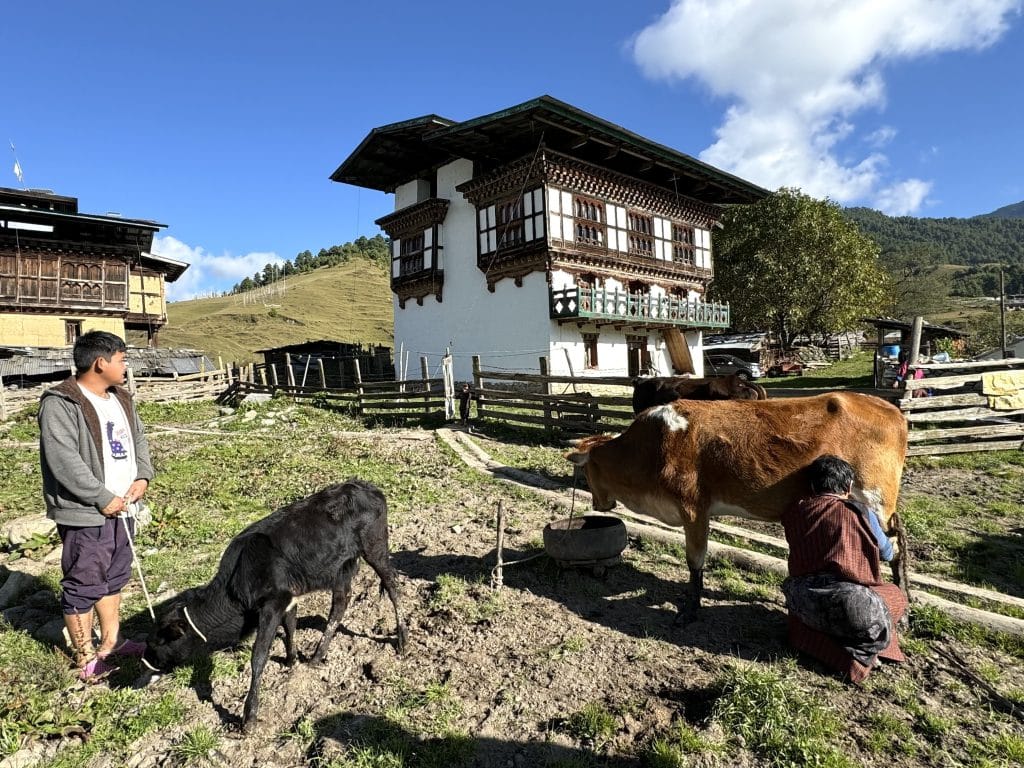 My farmhouse came with a milking session!
My farmhouse came with a milking session!Farmhouse homestays are a way to experience rural life in Bhutan.
If you want to experience rural Bhutanese life and see how the people truly live, see if you can book a farmhouse stay during your trip. You’ll stay in a local family’s home and eat with them. Don’t expect anyone to speak English, but your guide can do plenty of translating!
From being greeted with funny faces and screams from the three little boys to sharing a meal while sitting cross-legged on the floor to watching the cow-milking in the morning, this makes you feel like you’re a world away from where you came from.
However — I recommend you speak to your tour company in advance to make sure it’s within your expectations. As lovely as my family was, the accommodation was too basic for me.
It was very cold and there was no heat (though they generously offered several blankets), there was nowhere to shower or even wash my face (I brushed my teeth in the kitchen sink in front of everyone), the bed was as hard as a rock, and using the bathroom at night meant tiptoeing through the room where the hosts were sleeping, and I wasn’t comfortable with that, so I just held it all night long.
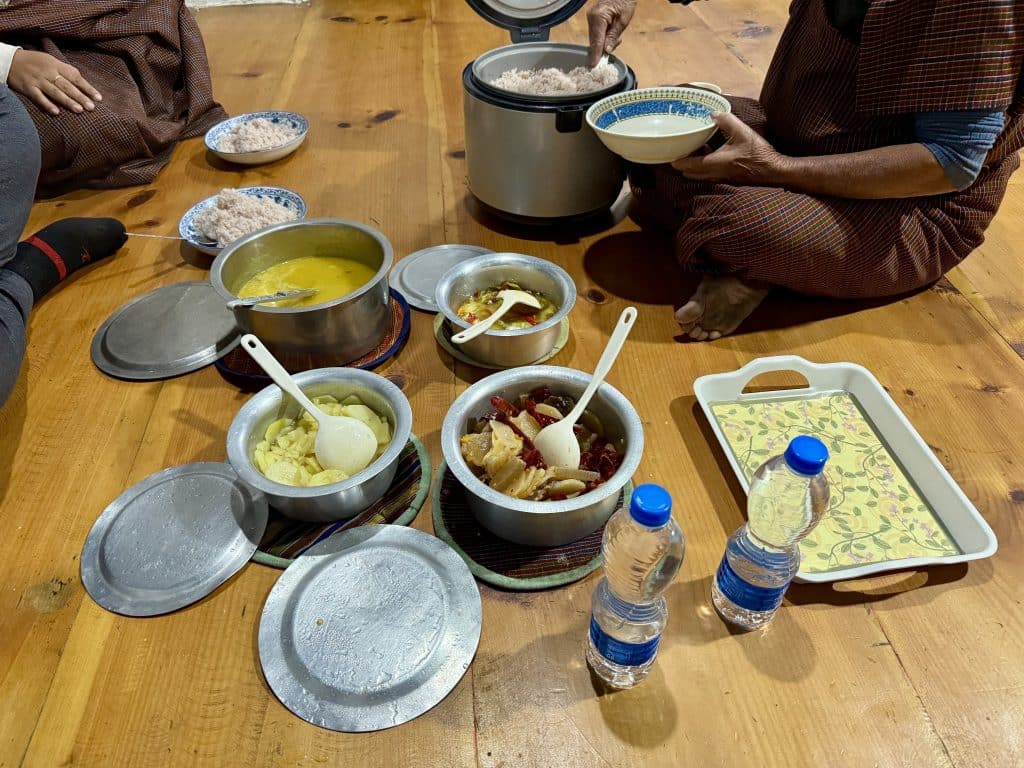 Our dinner for the evening.
Our dinner for the evening.Another thing to keep in mind is that rural Bhutanese people, like many Asians, sit on the floor most of the time with no chairs or support. If you’re from a culture that doesn’t sit on the floor, you’re over 30, and you don’t have a regular yoga or flexibility practice, you’re going to be uncomfortable sitting that way all night.
But a traditional homestay isn’t the only option. My guide Sonam told me that there are rural guesthouses that operate more like agriturismos in Italy. A few he recommends are Dhumra Farm Resort in Punakha and The Happiness Farm in Paro.
At these places you get a rural experience, local food grown in the garden — and a nice private bedroom and bathroom. Now, that sounds much more my speed, and perhaps it’s something you would like, too.
My advice is to decide what you’re comfortable with, and talk to your tour company in depth if they want to book you a farmstay. What are the accommodations like? Is there a shower? Is there heat? How private is your room? What is the bathroom situation? Is there only a squat toilet, or a western toilet?
And don’t do it two nights in a row. Originally I was supposed to do two farmstays in a row, but the day I got food poisoning, Bhutan Travel Center switched me to a hotel instead. If I had to go two nights in a row without washing at all, I would not have been happy.
(I did talk with Bhutan Travel Center about this, and urged them to tell their customers the details of their farmhouse in advance, especially the lack of a place to wash up, and not to book two nights in a row. They agreed that it would be good to share this information.)
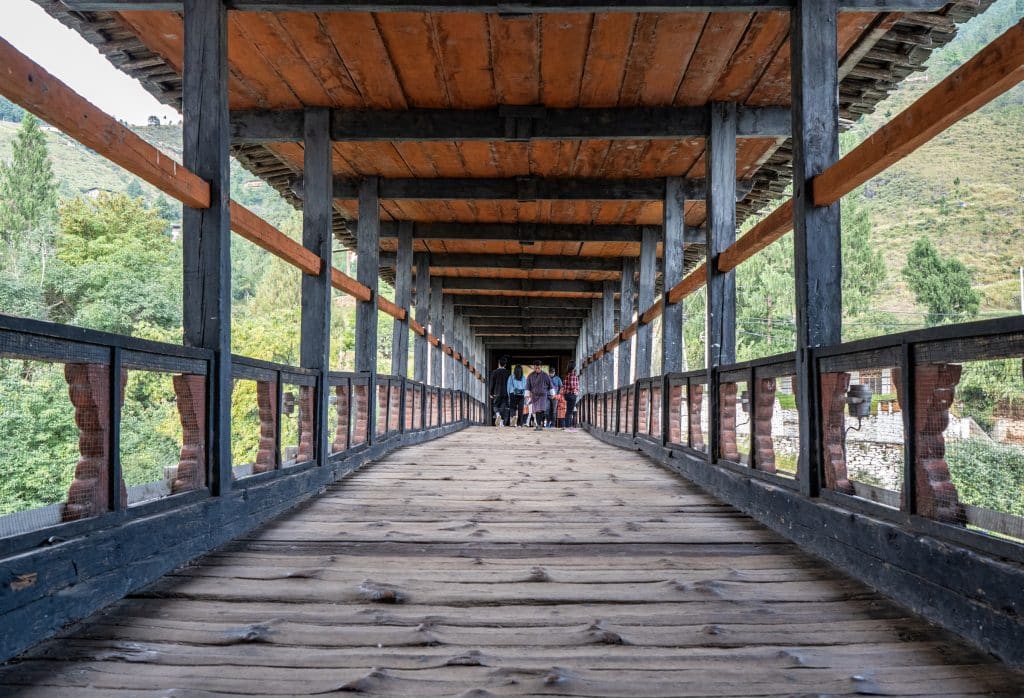 A covered bridge in Paro, right by the Dzong.
A covered bridge in Paro, right by the Dzong.How much does a trip to Bhutan cost?
Bhutan is not a destination for low-budget travelers, but I was surprised at how inexpensive it was for a private tour with both guide and driver.
My trip with Bhutan Travel Center was a seven-night trip with mid-range accommodation (excluding one night of basic accommodation in a homestay), all meals included, private guide, and private driver, and it cost $3200 — which includes the $100 daily Sustainable Development Fee (SDF).
If this trip had been for two people sharing a room, it would have cost $2600 per person.
Bhutan trips can also be quite expensive if you want to stay in luxury hotels. If you’re staying at any of the Aman, And Beyond, or Six Senses properties, you could pay upwards of $2000 per night! Bhutan Travel Center showed me a 13-day luxury itinerary they planned for two people, and it cost $7825 per person.
In addition to the trip cost, you need to pay the cost of the visa ($40), and the entry fees to temples, dzongs, and other sites — the total was under $100 for me.
You also need to tip your guide and driver. I struggled to find guidelines on how much to tip, and Bhutan Travel Center encouraged me to give at least $50, so I gave Sonam and Kencho each $150.
And then there are the flights. I paid $492 for my round-trip flights from Kathmandu on Druk Air. That’s a LOT for an hourlong flight each way!
On top of that, you’ll need to pay to get to your departure point. I booked my flights with miles, using my British Airways Avios for economy class Qatar Airways flights. I flew Prague-Doha-Kathmandu, and stopped in Doha for two nights on the way back. Total: 71,500 Avios and $322.20.
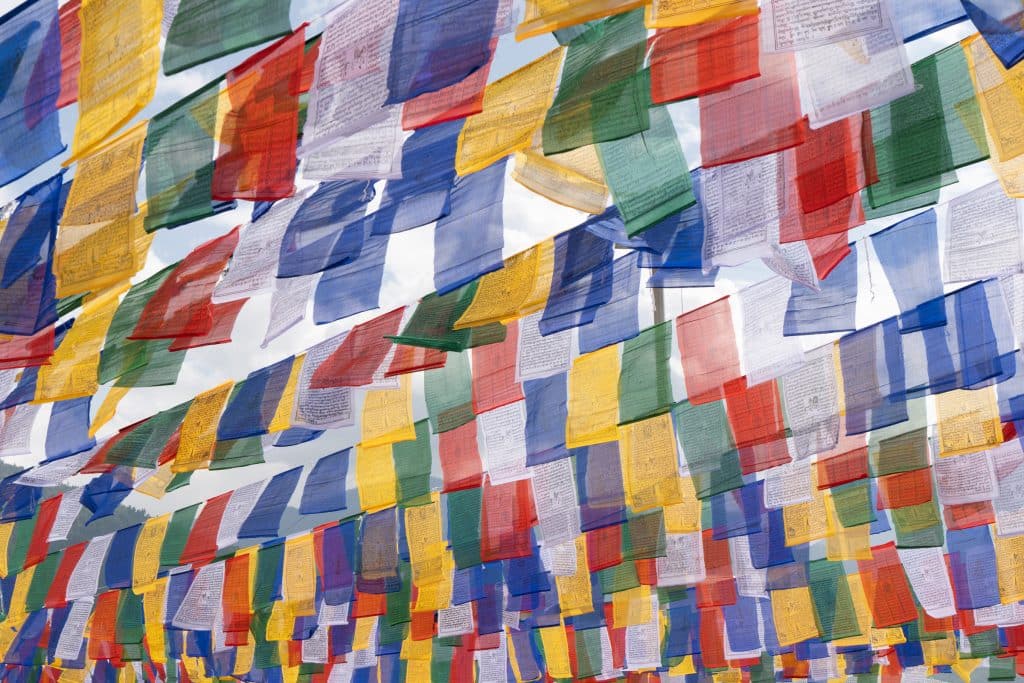 Prayer flags are one of the quintessential sights of Bhutan.
Prayer flags are one of the quintessential sights of Bhutan.While I usually get money from the ATM when arriving in a new country, Bhutan Travel Center warned me that ATMs often don’t work in Bhutan. Instead, on their recommendation, I brought US dollars with me to change; they also change euros or Indian rupee. I changed $100 at a shop in Paro, and that was enough to last the week. I tipped my guide and driver in USD.
Will you have any incidentals? I bought gifts from the shops with my credit cards — they added on a 3% transaction fee, which I didn’t mind.
Beyond that, I bought a coffee at Mountain Cafe, a nice cafe in Paro, and a few beers at Urban Dumra, a cool beer garden in Thimphu. That’s it. Because all meals were included in my trip, I didn’t really have to pay for anything extra.
So what did my Bhutan trip cost in total? For the flights and just the Bhutan portion of the trip, it cost $4,454.20. Bhutan Travel Center covered $2540 worth of the cost in exchange for coverage, so I personally paid $1,914.20 total.
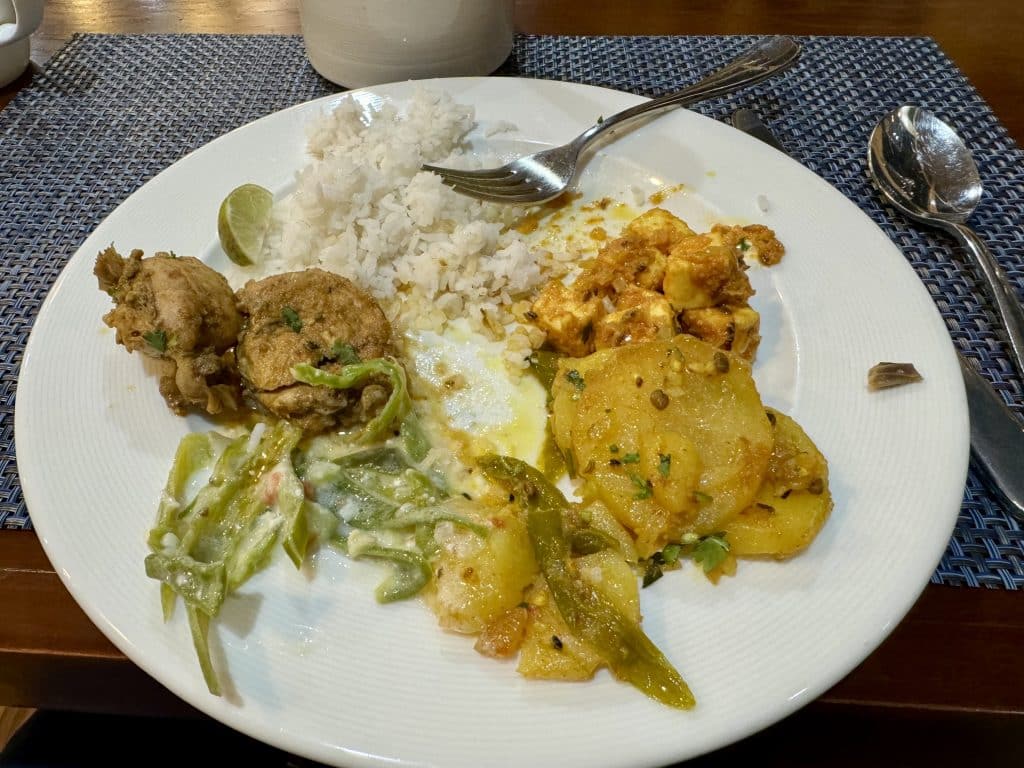
What’s Bhutanese food like?
I’ll be honest — while there are some tasty dishes to be had in Bhutan, this is not a place you go to for the food.
Bhutanese people eat a lot of dairy, which is a bit unusual by Asian standards.
If you go to someone’s home, they’ll probably offer you a butter tea, which has a salty, savory flavor to it. It’s served with cereal or puffed rice served out of an old cookie tin (talk about a universal experience!). You can mix the cereal or puffed rice with butter and add it to your tea.
The national dish of Bhutan is ema datshi, which is chiles and a soft cheese mixed together and stir-fried. It accompanies everything! Red rice, which is more pink, is often served with everything.
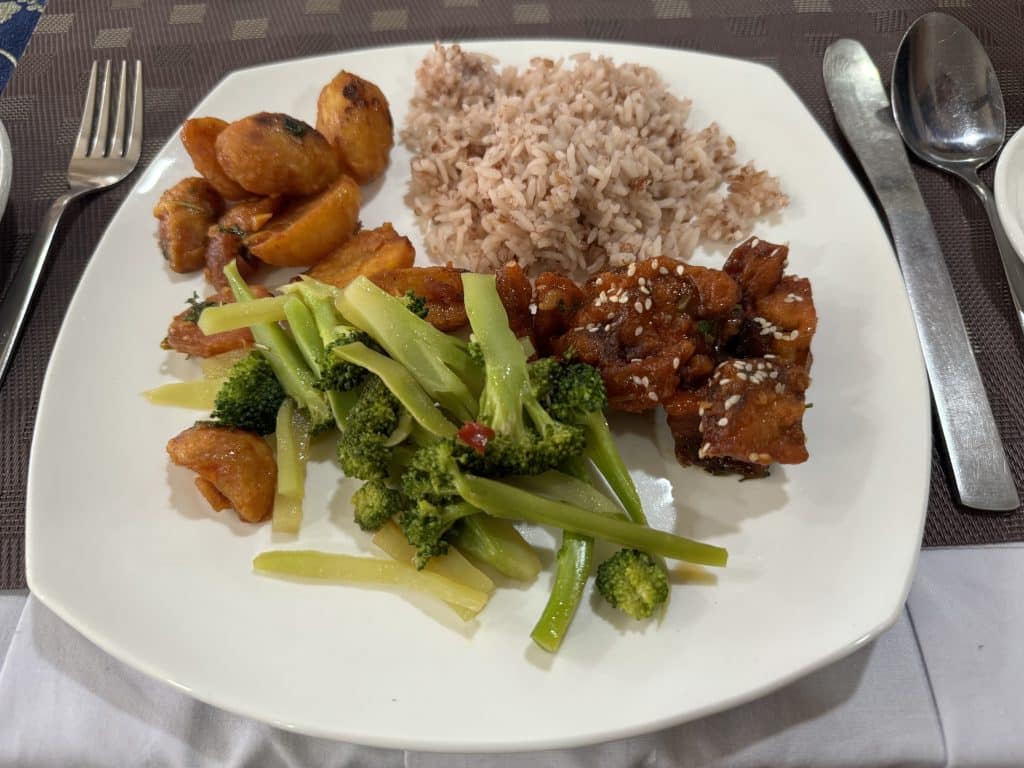 Red rice, which is more pink than red, is standard in Bhutan!
Red rice, which is more pink than red, is standard in Bhutan!What kind of restaurants do you visit on a Bhutan trip? Honestly, you usually have breakfast at your hotel, lunch at a restaurant catering to tourists, and dinner at your hotel.
All of these places are buffets, and they usually offer rice, ema datshi, lots of vegetables, one meat option, and often chow mein. Sometimes they’ll bring you a little dessert afterward.
I also need to share that I woke up with food poisoning on my second full day in Bhutan. Sonam insisted on taking me to the hospital in Paro, and I saw a doctor, got a prescription for Cipro, and felt much better from the afternoon onward. (The hospital visit was free. This is literally what the SDF pays for!)
I ate nothing but bananas and rice the next day and a half, then stuck to eating vegan the rest of the trip, except during the homestay (though the grandmother was distraught at how little I was eating, as all grandmothers would be!).
But my advice on food is to not keep eating something if it seems off. The day before I had a coffee with milk that had a filmy solid in it, and ate some chicken that seemed a bit…weird. I should have stopped eating both immediately, instead of thinking, “Oh well, I can’t be one of those wasteful Americans who doesn’t eat everything on their plate!”
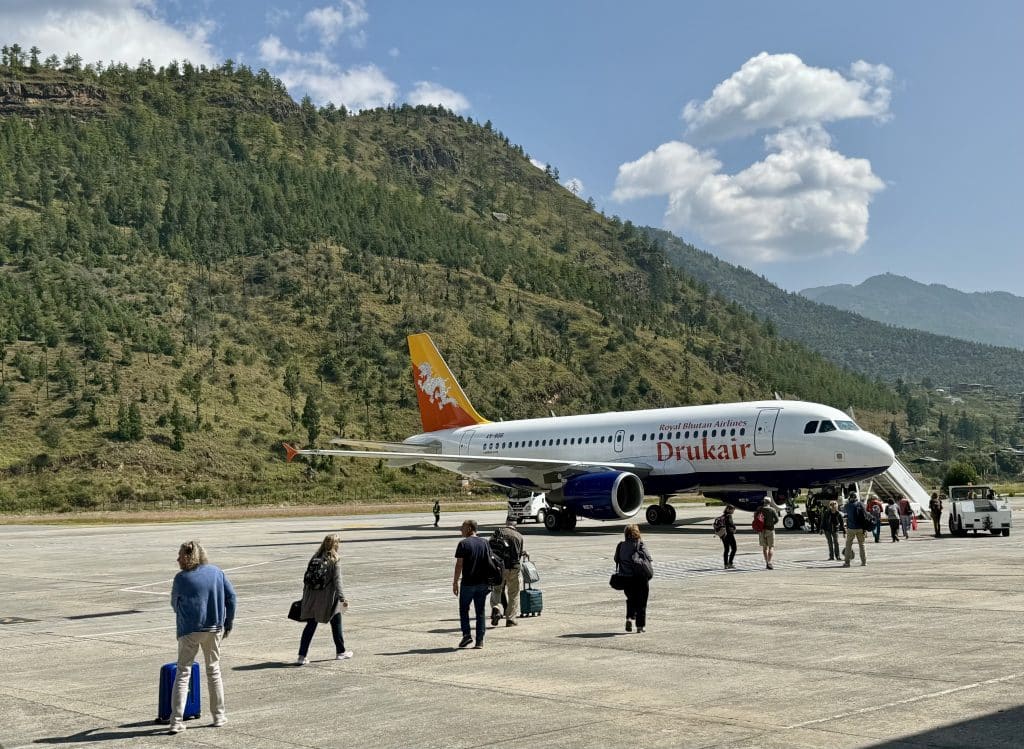 The best way to get to Bhutan is to fly in.
The best way to get to Bhutan is to fly in.How do you get to Bhutan?
To get to Bhutan, you’ll need to fly in on either of the Bhutanese national airlines: Druk Air or Bhutan Airlines. These airlines fly from a handful of cities, with direct flights from Kathmandu, New Delhi, Kolkata, Bangkok, and Singapore.
I chose to fly in through Kathmandu — it made sense to complement my week in Bhutan with a week in Nepal! If you’re traveling this far, it’s a great way to round out your trip.
While I don’t regret my time in Nepal, I should warn you that Kathmandu Airport is absolutely MISERABLE on every level. It’s now my least favorite airport in the world. I flew through that airport six times on this trip — FUN.
Knowing what I know now, next time I go to Bhutan, I think I might try to go via Bangkok or Singapore, just to avoid that airport!
And just FYI — both of my flights to and from Bhutan were rescheduled a few days in advance, each of them a few hours later, so I wouldn’t plan any tight onward journeys from Bhutan. I gave myself two days’ buffer on each side, just in case.
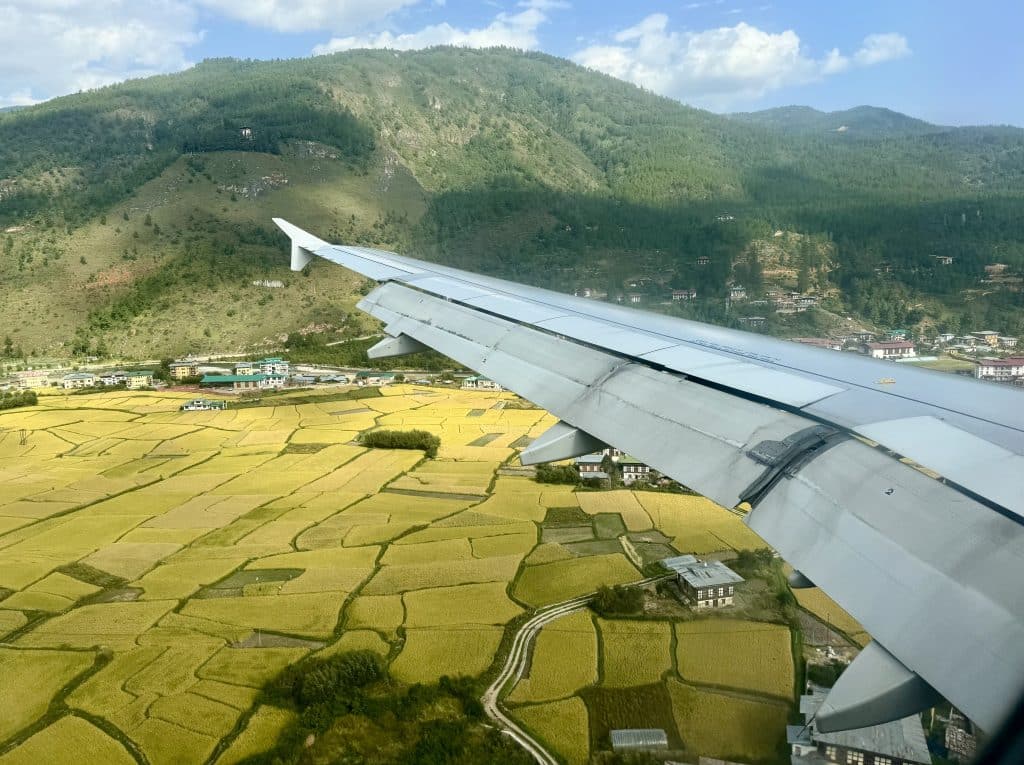 My eyes nearly fell out of my sockets as we flew into Paro International Airport.
My eyes nearly fell out of my sockets as we flew into Paro International Airport.Flying into and out of Bhutan is spectacular.
I highly recommend you get window seats for your flights to and from Bhutan. The flight in absolutely blew me away!
Flying into Paro, Bhutan, is a tricky landing, and only around 50 pilots in the WORLD are certified to do it!
Also, if you’re flying to or from Kathmandu, get a window seat on the left side of the plane from Kathmandu to Paro, and get a window seat on the right side of the plane from Paro to Kathmandu.
The reason? VIEWS OF MOUNT EVEREST. The pilot will let you know when you’re passing the tallest mountain in the world! I missed it on my flight in due to cloud cover, but caught it on the way back, and it was spectacular!
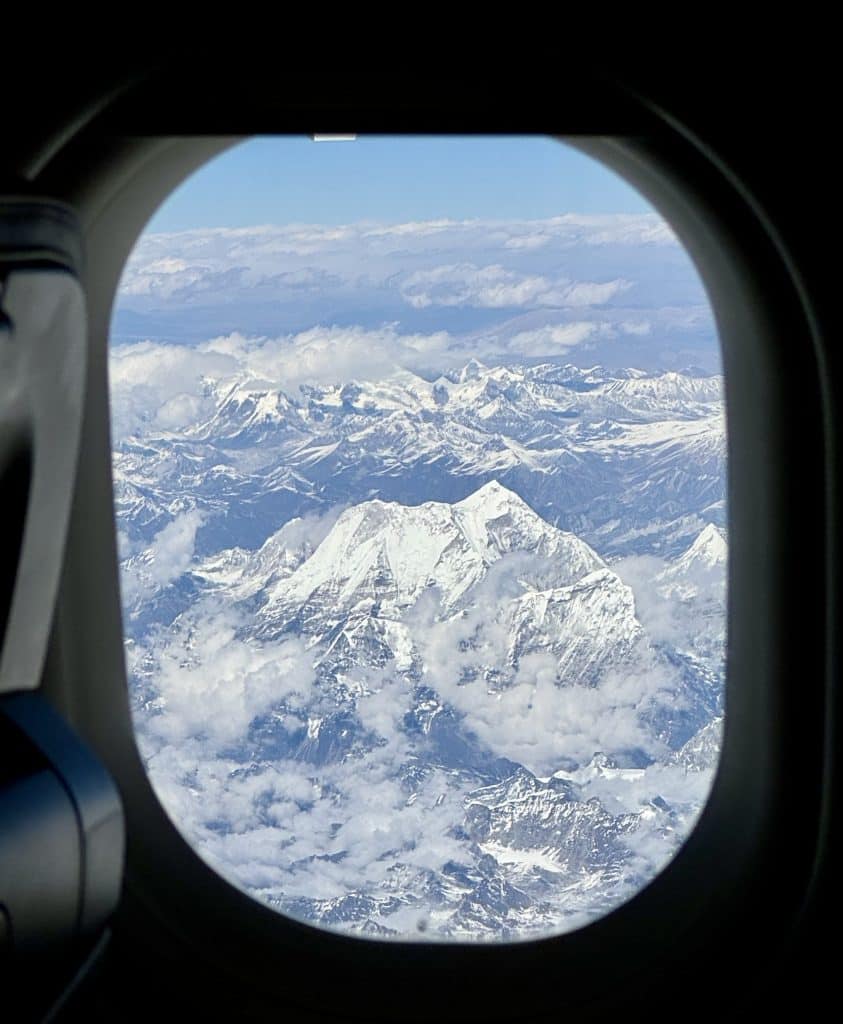 Yes, this is Mount Everest!
Yes, this is Mount Everest!A few days later, I was back at Kathmandu Airport waiting to fly to Pokhara, and there were tons of travelers there for early scenic flights to Mount Everest.
These flights cost hundreds of dollars. It felt awesome that I got to experience that for free when flying from Kathmandu to Paro!
Druk Air opens check-in three days in advance, and I recommend you check in as early as possible to get a window seat on the correct side. They go very quickly.
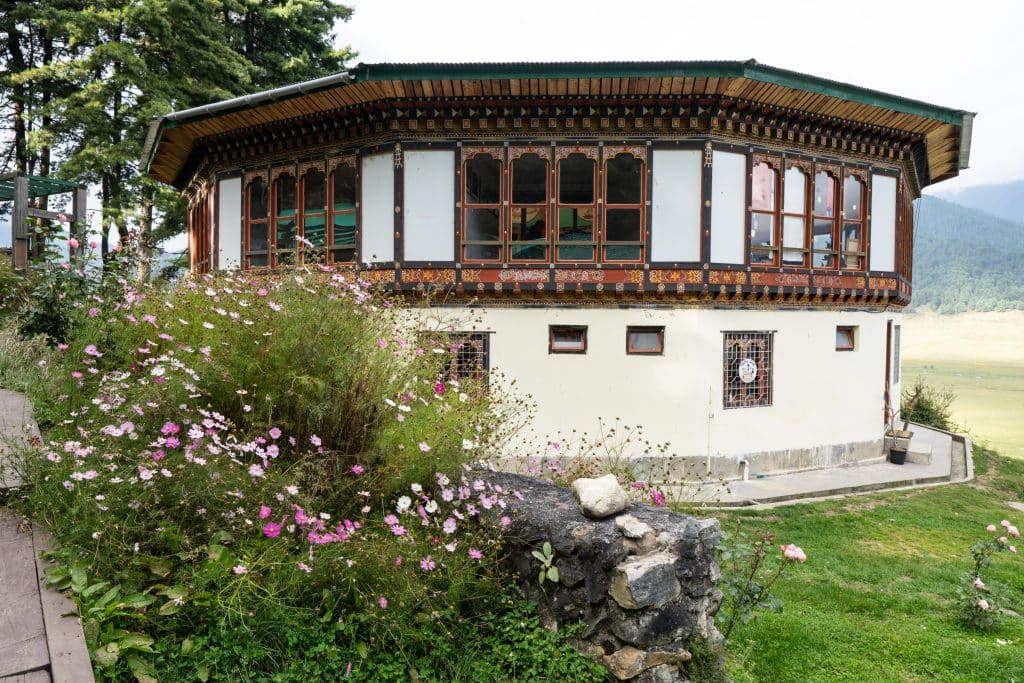 Come to Bhutan in spring or fall.
Come to Bhutan in spring or fall.When is the best time to visit Bhutan?
The best time of year to visit Bhutan is either spring or fall. These are the months with the best weather, and also the popular months for festivals, which makes them high season.
Winter brings colder temperatures and snow, and the summer months bring heavy rains, with the monsoon season lasting from June through September.
I visited in October because I wanted the best weather possible, and October also happens to be the peak tourism month of the year. Even so, the only place that felt slightly busy was Punakha Dzong, well known as the most beautiful building in the country, and everywhere else was just quiet.
One other thing — I was originally supposed to attend the Jomolhari Mountain Festival in Bhutan, but the dates were changed at the last minute. That was a big disappointment, as I had my heart set on it.
Thankfully, Bhutan Travel Center put together a “cultural night” for their clients with several dance performances in brightly colored costumes. That was nice.
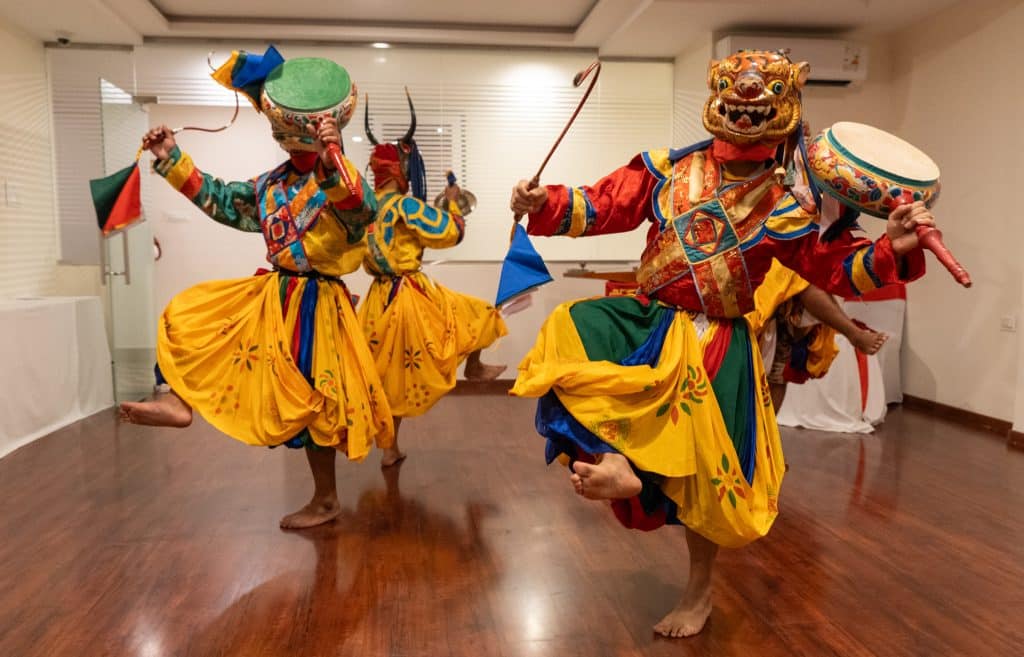 The dances in Bhutan are so cool!
The dances in Bhutan are so cool!Internet is not great in Bhutan.
You shouldn’t expect good internet in Bhutan, even with local SIM cards. It was hard to find a decent eSIM, and my husband found me one through a company I hadn’t heard of called RedTeaGo.
How good was it? It basically only fully worked when in the downtowns of cities. Outside cities, half the time it didn’t work at all, and half the time only a few apps would work, including WhatsApp, iMessage, Threads, and sometimes Facebook. Oddly, not Instagram — so it’s not a Meta thing.
So if you’re hoping to get a bit of work done in Bhutan — honestly, I wouldn’t if I were you. But if you need to be in communication with your loved ones, the hotels have pretty decent internet access.
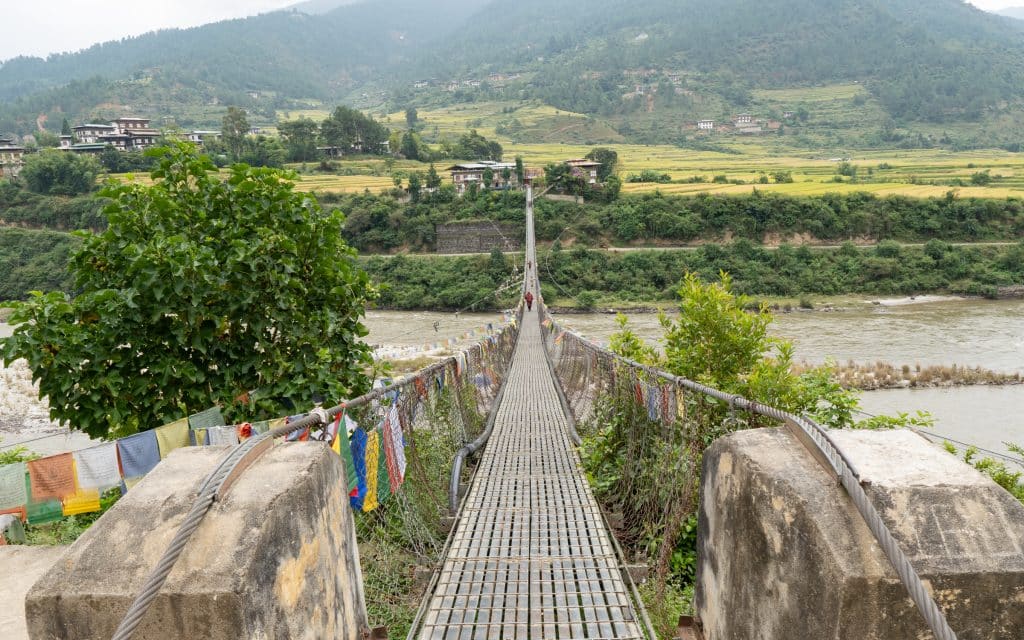 Say hello to the longest suspension bridge in Bhutan!
Say hello to the longest suspension bridge in Bhutan!Communication can be a bit tough sometimes.
I’m not talking about speaking the local language — most people who work in tourism in Bhutan speak English, though if you learn a few Bhutanese words, it will be appreciated! I’m talking more about cultural clash with communication, which isn’t necessarily a Bhutanese thing, but more of an Asian-vs-western thing.
For example, before my trip I asked the team which day I would be able to do laundry. They responded, “Don’t worry, you will be able to do laundry on your trip.”
That’s great, but I was trying to figure out which day so I knew how much to pack. I told them this and they gave me the same reply: “Don’t worry, laundry is not a problem.”
I took a look at my schedule, saw I had two nights in Thimphu mid-trip, and replied, “Can I do my laundry at the Thimphu hotel?”
“Oh yes, you can do laundry at the Thimphu hotel.” Okay. That answered my question.
I want to emphasize that neither of us was wrong. It’s simply a cultural difference — I was direct and they were indirect, but we got to the same place eventually.
If you’re planning a Bhutan trip, just know you’ll be having lots of conversations like this where you wonder if you’re really understanding each other! Just be more detailed.
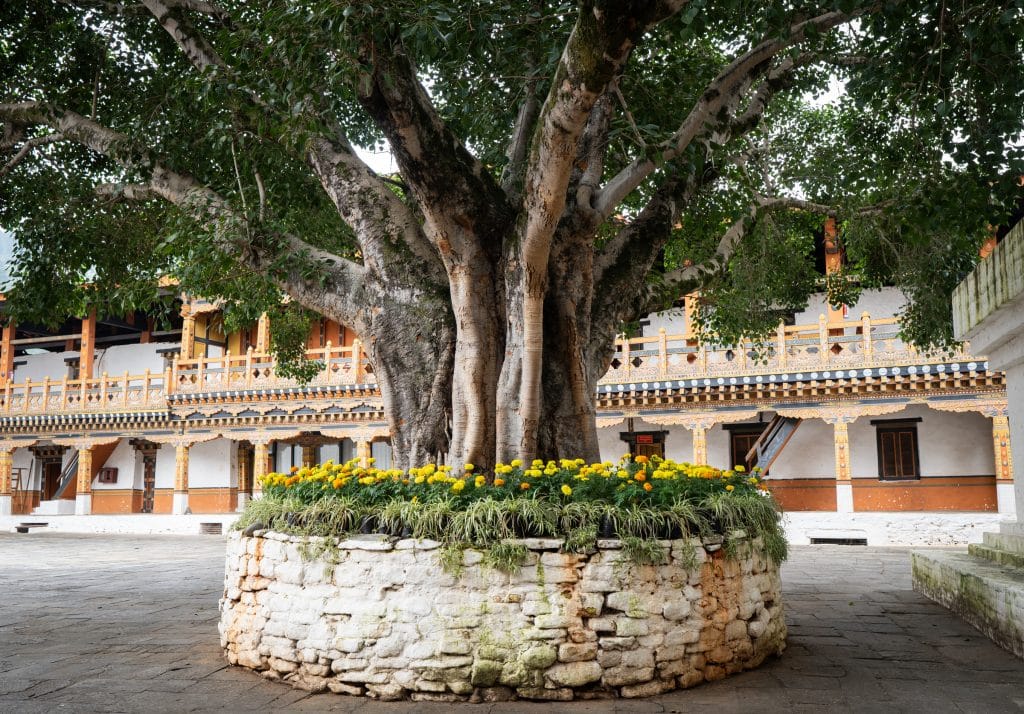 This Bodhi tree in Punakha came from the Bodhi tree in Sri Lanka where Buddha experienced enlightenment.
This Bodhi tree in Punakha came from the Bodhi tree in Sri Lanka where Buddha experienced enlightenment.Bhutan is not without its issues.
The way I describe Bhutan sounds utopian in lots of ways — but that doesn’t tell the full story. As incredible as this country is, there are some very real problems the country is facing.
One big one is migration. Bhutan’s population is shrinking, with many young people leaving the country for economic opportunities elsewhere. Often in Australia, which has a robust Bhutanese community (in fact, the King was visiting Australia at the time of my visit).
It’s understandable — this is a small country with limited opportunities, and the fertility rate is dropping as well. You can read more about that in this article from The Bhutanese.
Another issue in the country is substance abuse, which of course is a universal issue around the world. Drug and alcohol addiction is having a particular effect on Bhutan, and you can read more about that in this Foreign Policy article.
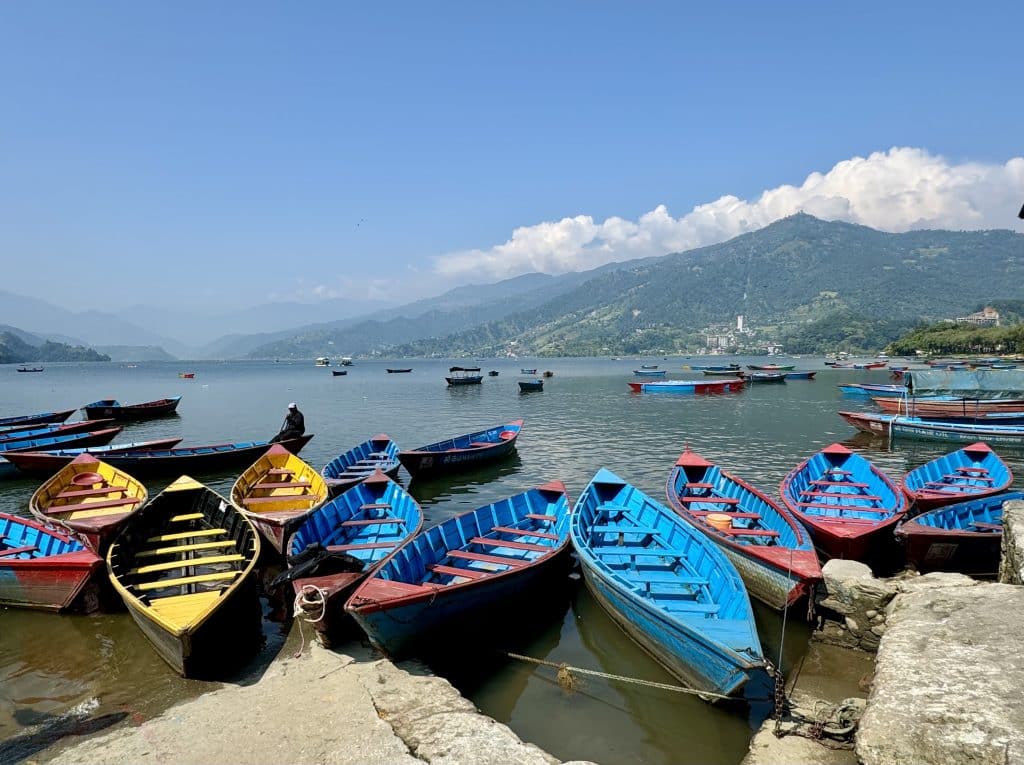 Phewa Lake in Pokhara, Nepal
Phewa Lake in Pokhara, NepalVisiting Nepal after Bhutan is jarring.
I should have known better — I need to be VERY careful in choosing where to travel right after an exceptional destination.
The next place always looks worse by comparison. It was hard to appreciate the island of Hvar in Croatia right after a few blissful days on the sublime island of Vis, for example.
But it was particularly jarring to spend time in Nepal after Bhutan because they could not be more different. Nepal is crowded, chaotic, and sadly, very poor and a victim of corruption. Not to mention the air quality was absolutely terrible in Kathmandu.
It’s not that I don’t love developing countries or chaotic cities — I do! But Nepal and I did not gel at all. That’s fine. You don’t need to be in love with every country you visit. But I’m glad I made the effort to visit a few different places there, just to see what it’s like.
So just be cautious — if you REALLY like Bhutan, the way I did, you may be putting your next destination at a disadvantage.
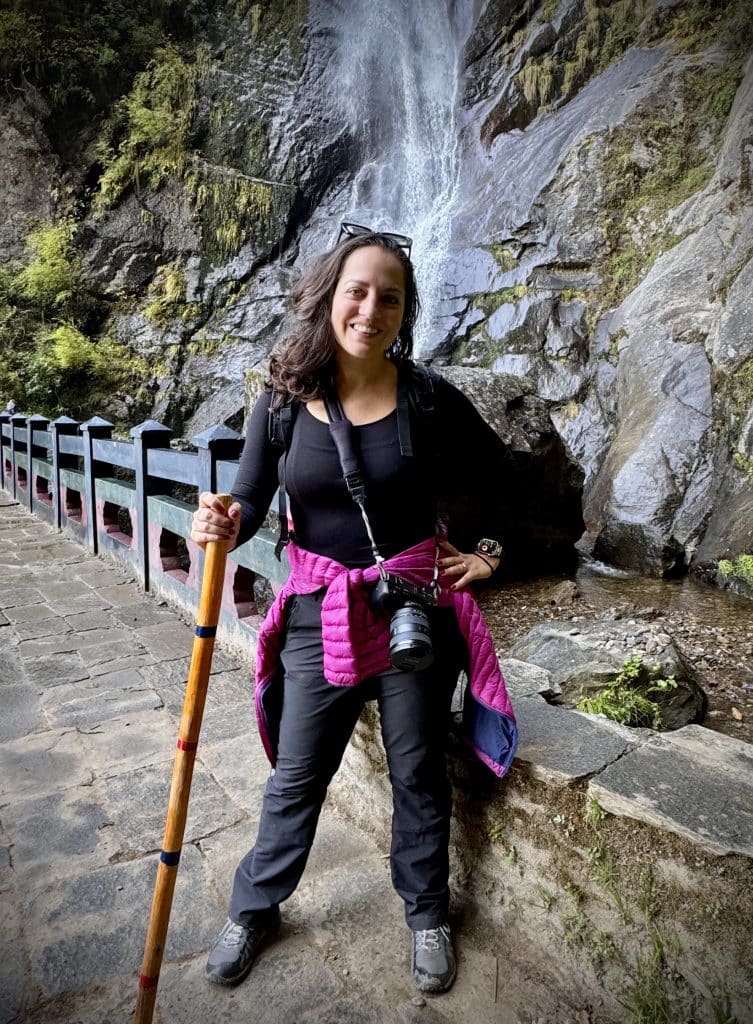 You’ll wear hiking gear most days in Bhutan.
You’ll wear hiking gear most days in Bhutan.Bhutan Packing List
Good news — you don’t need to pack anything fancy for Bhutan! Hiking clothes are perfectly fine to wear throughout your trip. I wore hiking clothes almost every day, but I also wore jeans on occasion when there wasn’t any hiking.
Here’s what to pack:
Your go-to hiking clothes — In October, I wore my hiking pants, one of my Uniqlo base layer tops, and merino wool socks most days. Depending on the temperature, I would layer my Patagonia puffer jacket on top, and while I didn’t end up needing it, I brought my waterproof rain jacket to wear on top.
Hiking boots — I wore my Merrill trail runners for my entire trip (mostly because I couldn’t find my hardcore hiking boots before I left — oops!). I was fine, but I do wish I had a bit more ankle support on the Tiger’s Nest hike. You may want to bring your good waterproof hiking boots.
Sandals — On non-hiking days, it’s much easier to slip sandals on and off when you visit temples. I started wearing Birkenstocks this year and I am never going back. They are THE BEST and THE MOST COMFORTABLE.
Sunscreen — The sun is SO much stronger in the Himalayas due to altitude, and you can see older Bhutanese folks have a lot of skin damage. You need to wear sunscreen every day (yes, everywhere, but especially in Bhutan). I absolutely love Supergoop Unseen Sunscreen — it’s clear, has no scent, and doesn’t irritate your eyes.
Wide-brimmed hat — A wide-brimmed hat is one thing I didn’t bring that I wish I had brought with me. Again, for sun protection while on hikes.
Water bottle — I actually brought my regular Nalgene water bottle for this trip, as well as my Lifestraw water bottle, which purifies water as you drink it, as the water in Bhutan is not safe to drink. I didn’t end up needing the Lifestraw once, as hotels and restaurants were generous with giving out filtered water.
Motion sickness tablets — You’ll need motion sickness pills or motion sickness bands if you get carsick, because you’ll be going on a lot of long, twisty drives through the mountains.
Lip balm — You dehydrate easily at altitude, and my lips were dry and flaky for most of the trip. I used my medicated lip balm about 20 times a day.
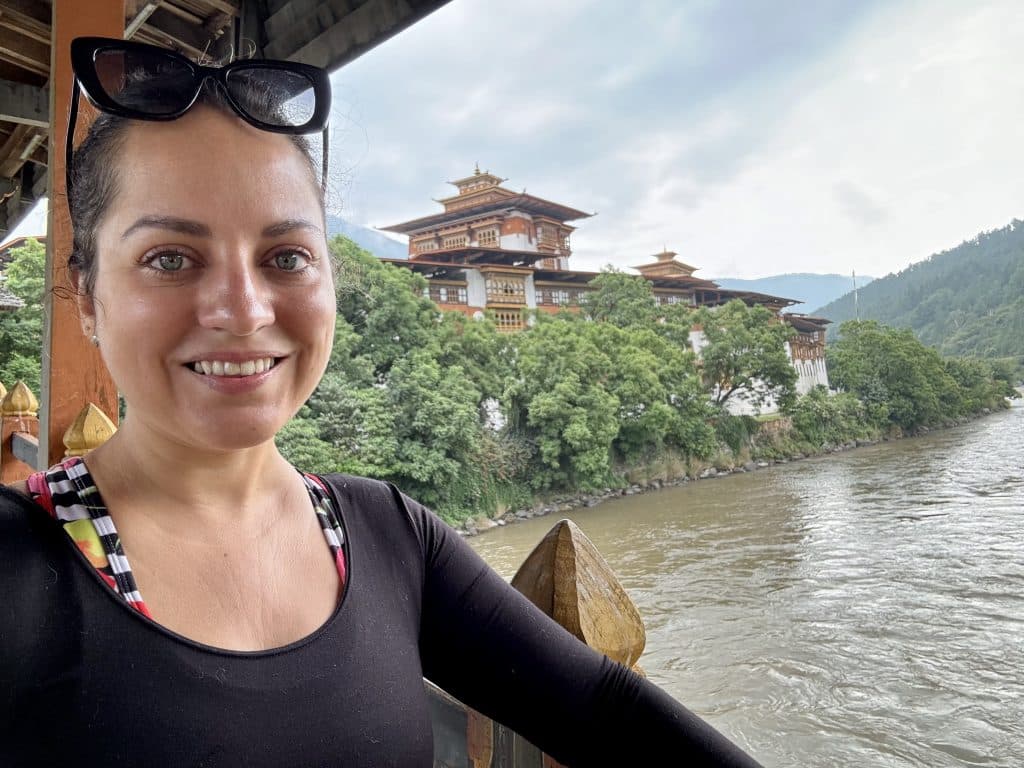 I loved my time in Bhutan!
I loved my time in Bhutan!Is Bhutan Worth It?
Bhutan is one of the MOST worth it countries I’ve ever visited. Yes, it was expensive visiting here, but I feel like getting to visit a country this unusual and special is absolutely worth the price tag.
If anything about this post resonated with you, I encourage you to get serious about planning a trip to Bhutan. This is one of the most special places I’ve ever visited.
More “What’s it like to travel here?” posts:
- What’s it like to travel to Greenland?
- What’s it like to travel to Albania?
- What’s it like to travel to Antarctica?
- What’s it like to travel to Armenia?
- What’s it like to travel to Guyana?
- What’s it like to travel to Lebanon?
- What’s it like to travel to Japan?
- What’s it like to travel to Antigua and Barbuda?
Does Bhutan sound like your kind of destination? Share away!
The post What’s it Really like to travel to Bhutan? appeared first on Adventurous Kate.

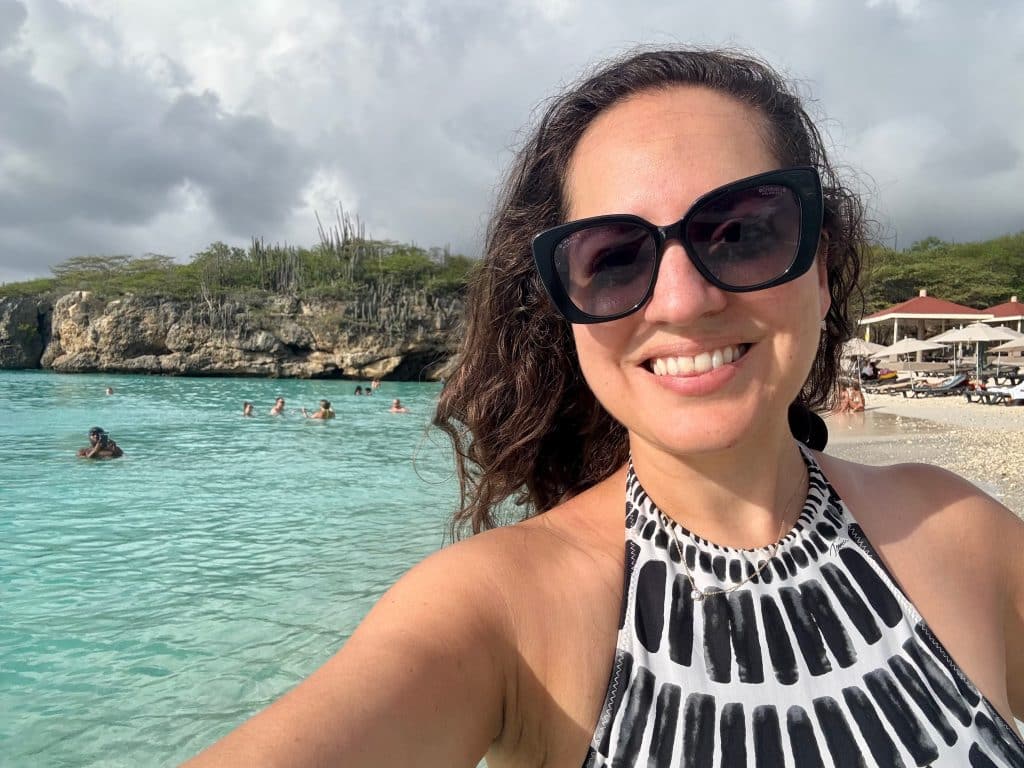


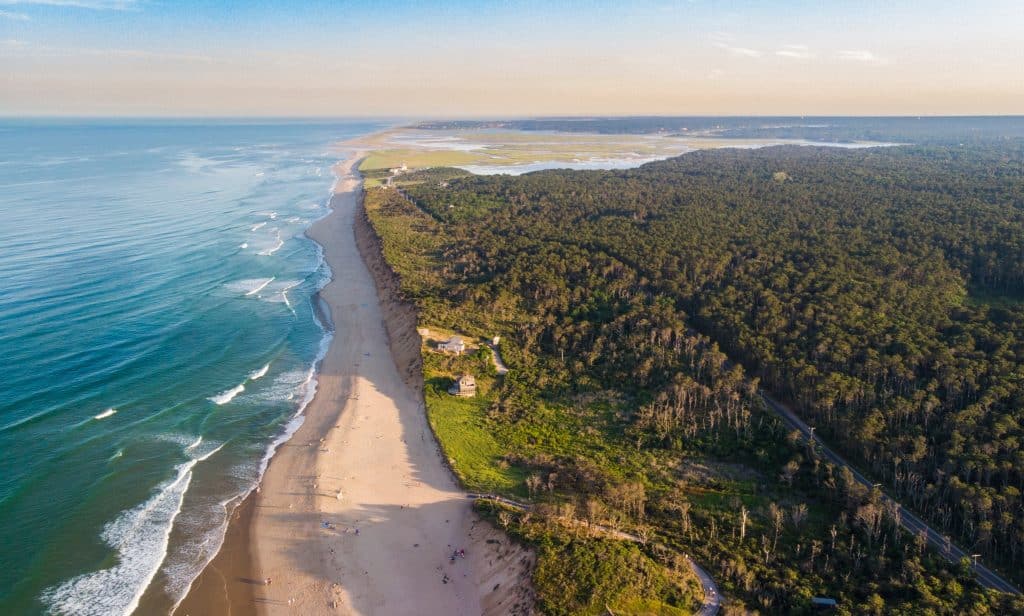
 English (US)
English (US)